
Catherine Park is a large park, which is an architectural monument of the 18th and 19th centuries, as well as one of the most picturesque and visited parks in St. Petersburg.
Catherine Park, together with the nearby Alexander Park, is an integral part of the former Tsarskoye Selo Imperial Residence and is part of the State Museum-Reserve "Tsarskoye Selo".
The name" Catherine " park was given to the Catherine Palace located in the park, named in honor of Catherine I.
There is a park with a palace in the city of Pushkin in St. Petersburg.
Catherine Park has an area of more than 100 hectares.
It consists of two parts: a regular Old Garden and a landscape English Park.
On the territory of the Catherine Park there are: pavilions, some of which now contain museums, sculptures, monuments and bridges built in various architectural styles, as well as piers, ponds, flower beds, alleys and paths for walking with places for recreation.
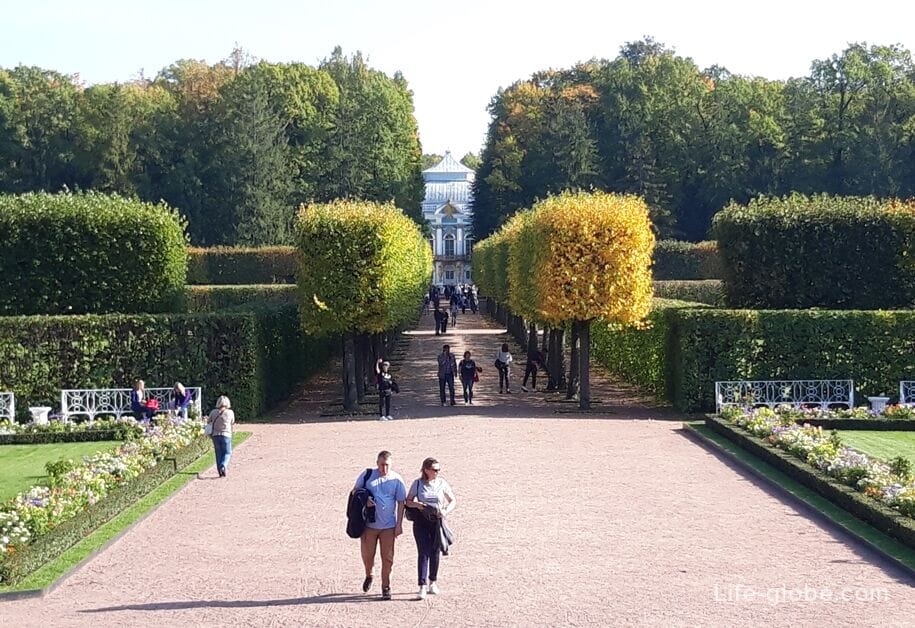

The formation of the Catherine Park, as well as the palace of the same name, was associated with the expulsion of the Swedes from this territory under Peter I. After that, on the site of a small Swedish estate, for Catherine I (the wife of Peter I), a small Tsaritsyn Palace with an adjacent garden was erected, which later became known as Catherine's.
The appearance of the Catherine Garden began with its regular part, which is also known as the Old part of the park.
The regular part of the park, adjacent to the Catherine Palace on its eastern side, was laid out in the 1720s by the Dutch masters of landscape gardening Ya. Roosen and I. Focht. In the middle of the 18th century, the garden was expanded, redeveloped and decorated with sculpture, and f. Rastrelli designed some of the park pavilions. Also on the territory to the south of the palace and around the Large Pond, in the 1770s, the landscape "English garden" was laid out, begun under the direction of V. I. Neelov and completed by the garden master I. Bush.
Later, the park was filled with new pavilions and monuments, including those in the classical and once fashionable Chinese styles, as well as monuments dedicated to the victory over Napoleon, the victory in the Russian-Turkish War, and its own imperial garden with a fountain and a verandah (pergola), made in the Italian style.
For two centuries, Tsarskoye Selo was the official summer ceremonial imperial residence, mainly of Catherine I, Elizabeth Petrovna and Catherine II.
After the October Revolution of 1917, the palace and park ensemble was turned into a museum.
During the Great Patriotic War, the Catherine Palace and the adjacent park with pavilions were significantly destroyed. After that, they were restored, including according to drawings, materials, photographs and preserved fragments of decoration.
Today, the Catherine Park, together with the palace, is included in the UNESCO World Heritage List and is a museum.
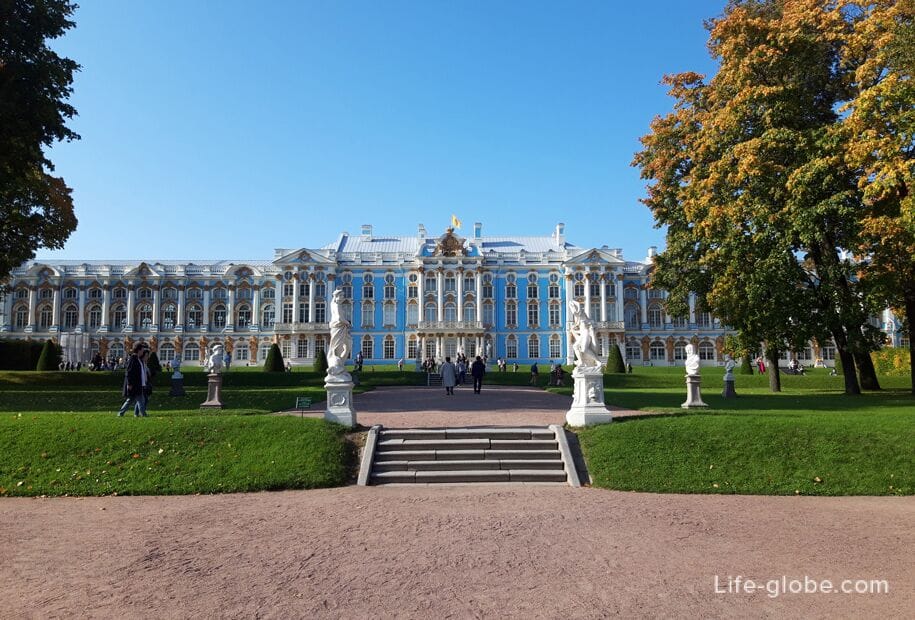
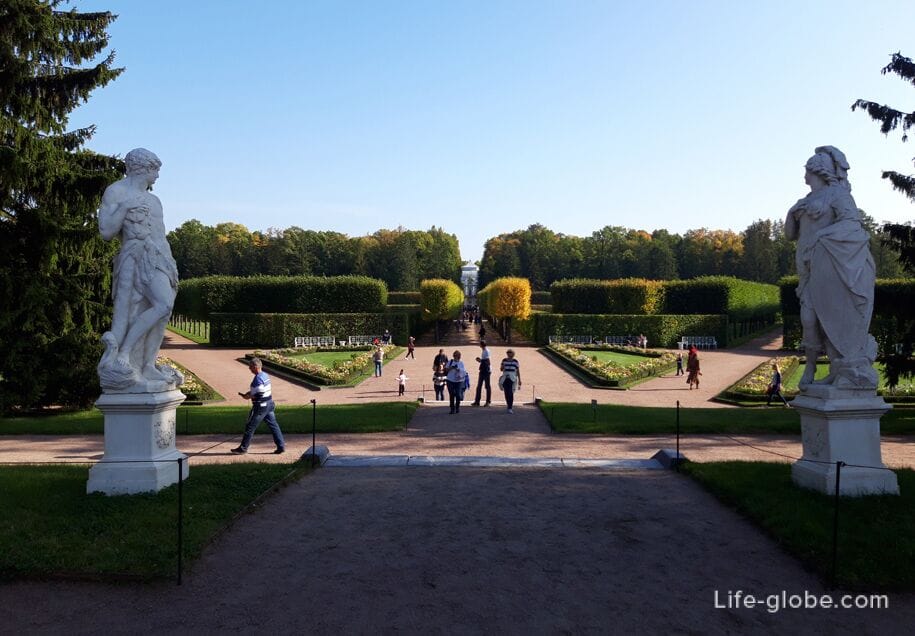
On the regular part of the park, in its entire width, the eastern facade of the Catherine Palace opens.
The exterior of the palace has a late rich Baroque style with a delightful picturesque decor: white, blue and gold colors; three-dimensional and massive columns, pilasters, sculptures and other decorations of the facades of the palace, harmoniously combine with each other and give the impression of grandeur and conviviality. Learn more about the Catherine Palace…
In the palace (for a fee) you can visit the restored palace halls, as well as (for a fee) - the church of the Catherine Palace (Resurrection of Christ) and the memorial museum-lyceum, located in the palace wings.
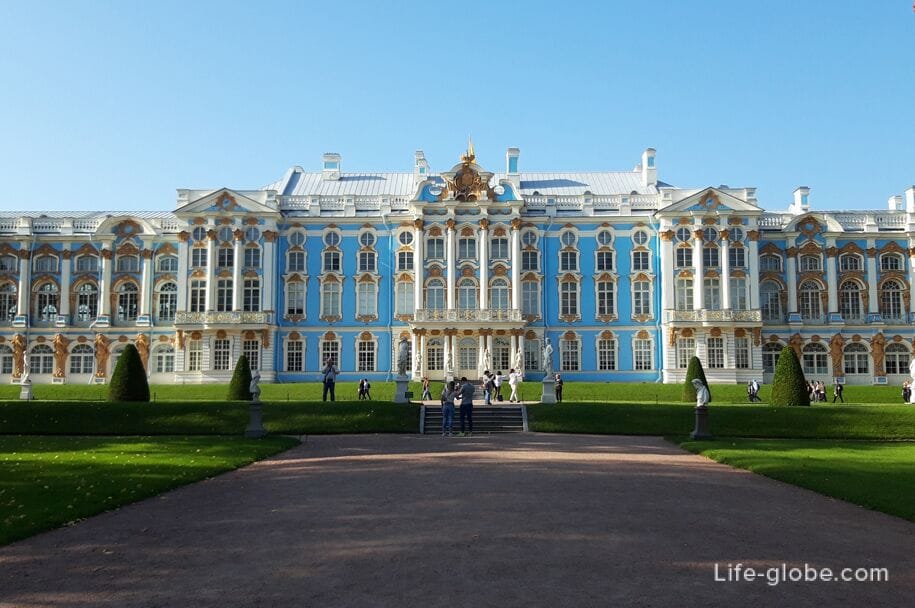
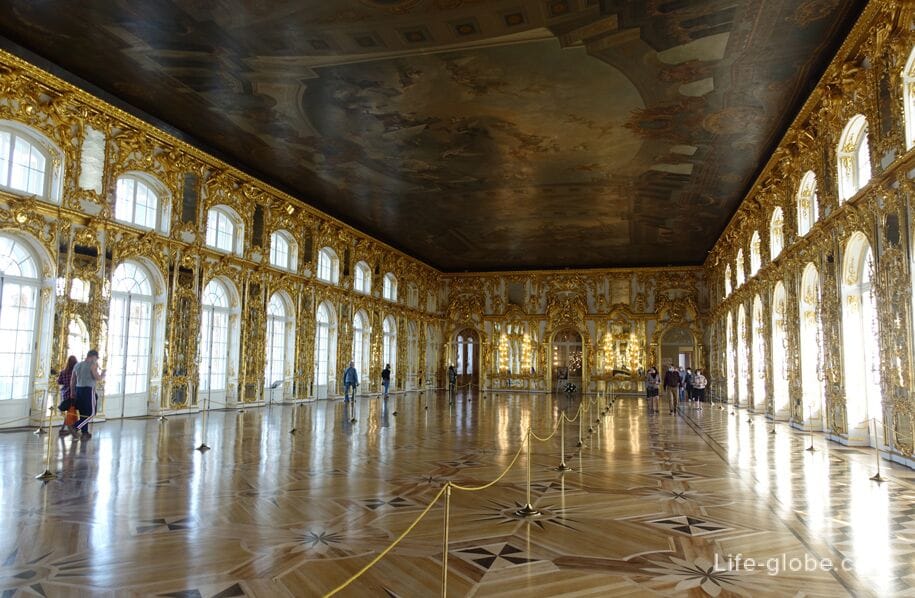
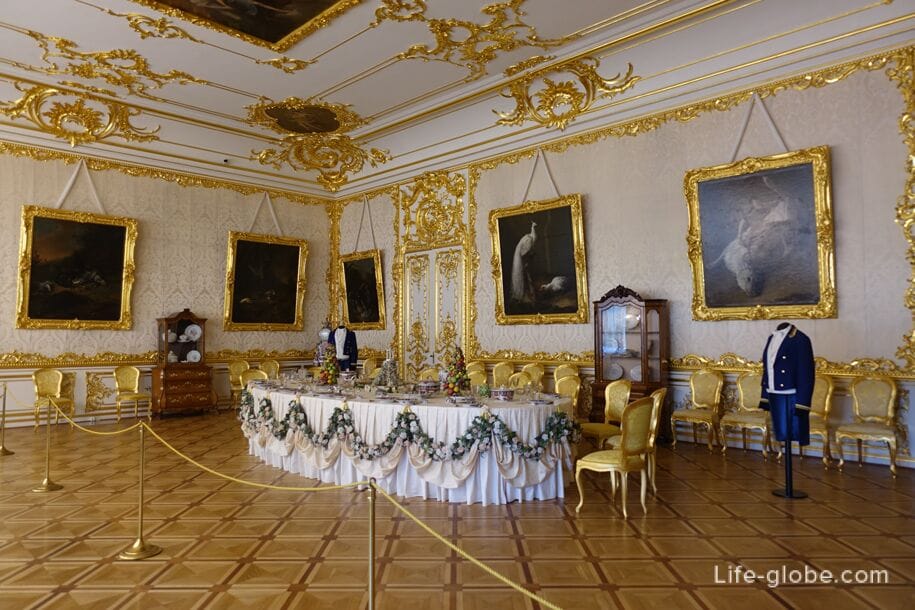
From the south, the palace is adjacent to the architectural ensemble "Cameron Baths", consisting of: the pavilion "Cold Bath" with Agate rooms, the Cameron Gallery with an adjacent Maid of Honor Garden, a Hanging garden and a ramp. Read more about the Cameron Baths ensemble with photos…
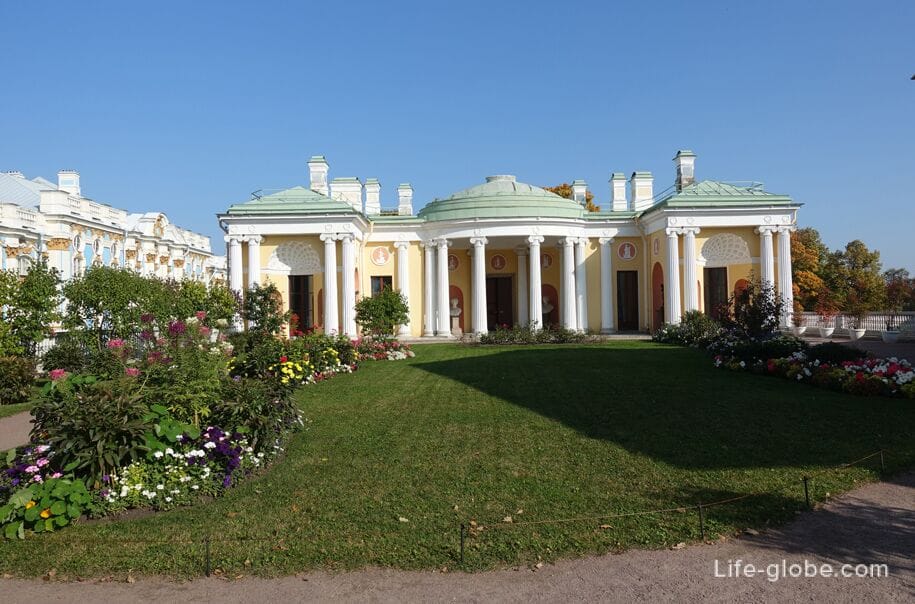
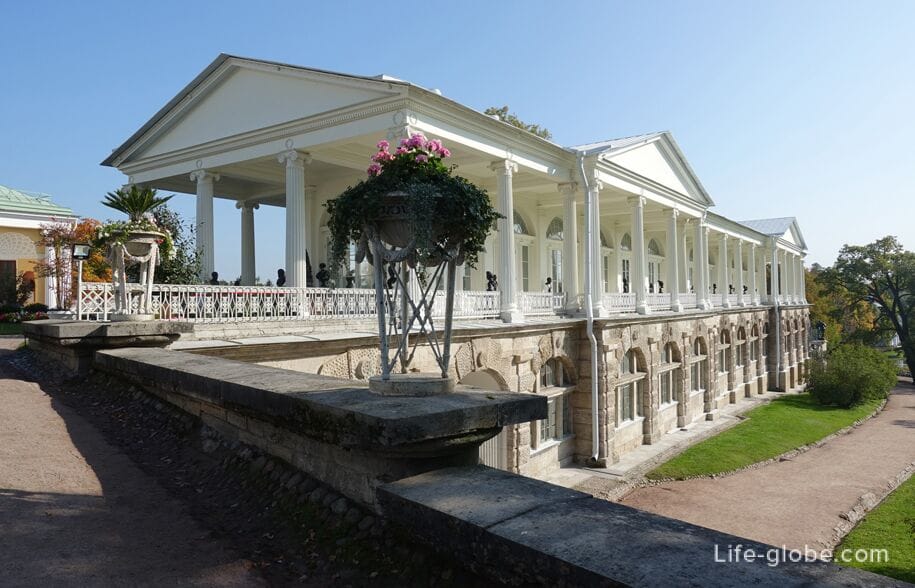

The regular part of the park is decorated with parterres and flower beds, decorative shrubs and trees forming secluded alleys for walking, a fountain, marble statues and busts, originally the work of Venetian masters of the early 18th century: D. Bonazza, P. Baratta, A. di Tagliapietra, B. Modolo, D. Dzeminiani, D. Dzordzoni and A. Tarsia.

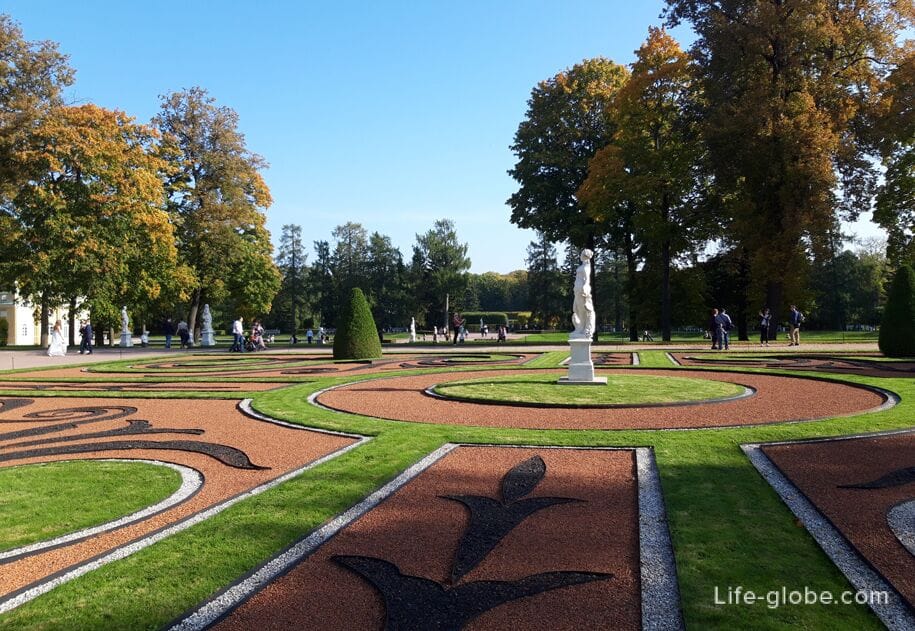
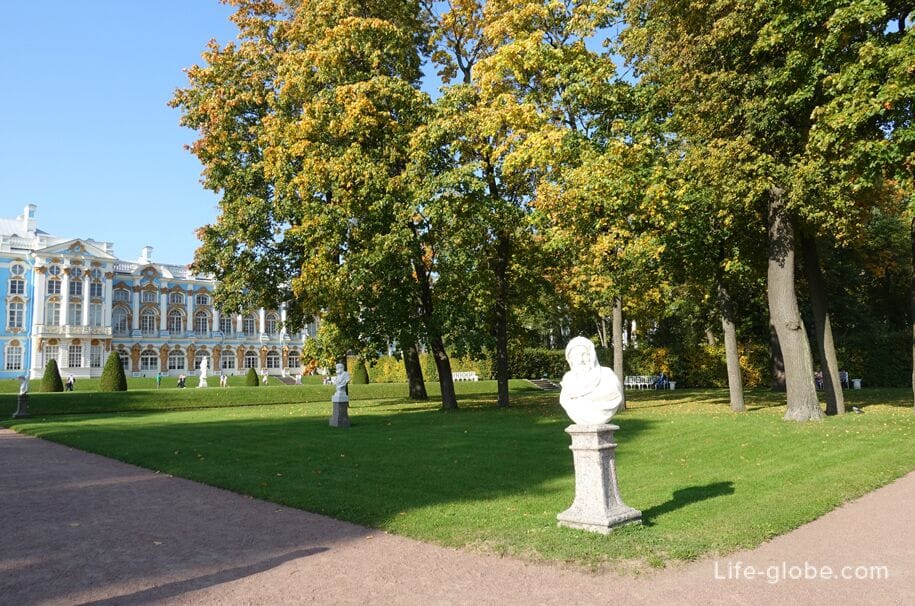
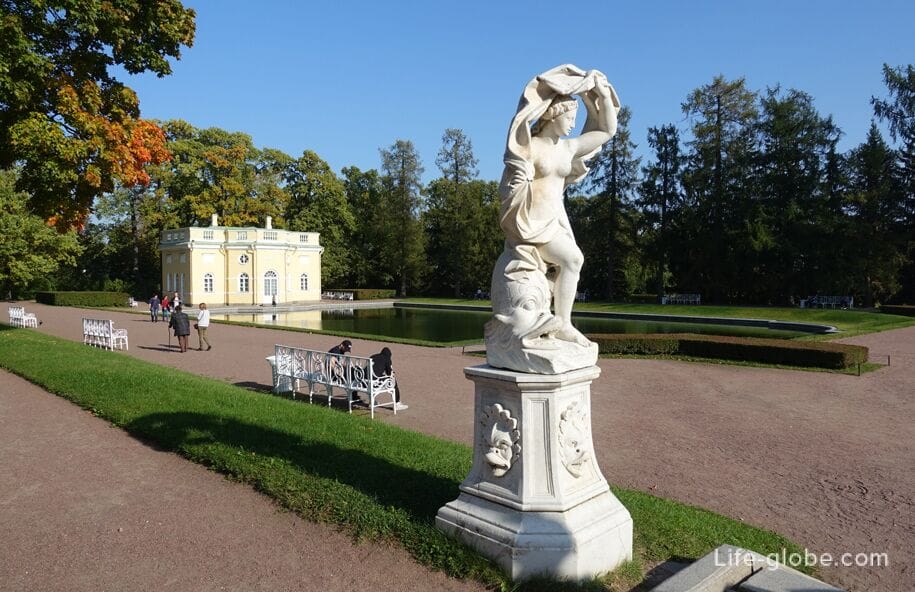
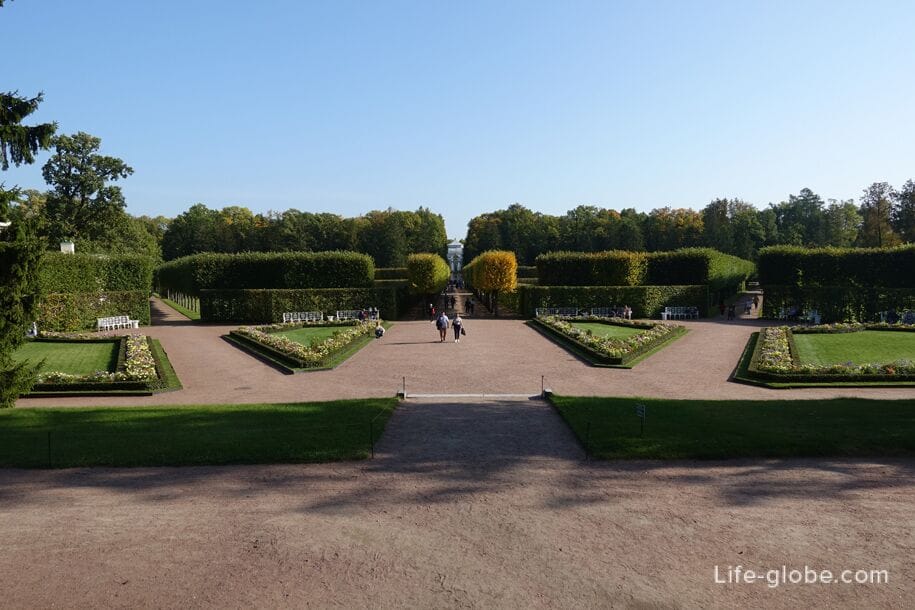
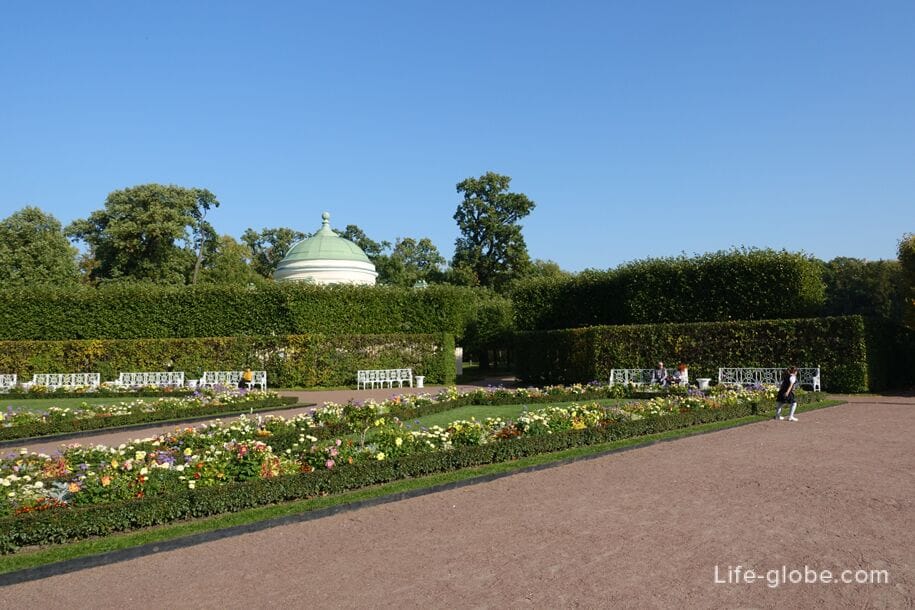

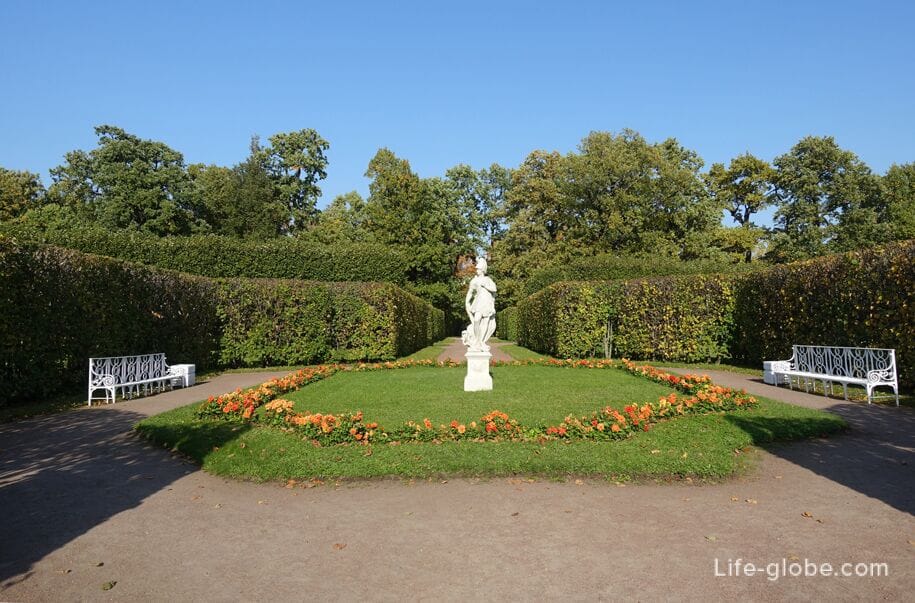


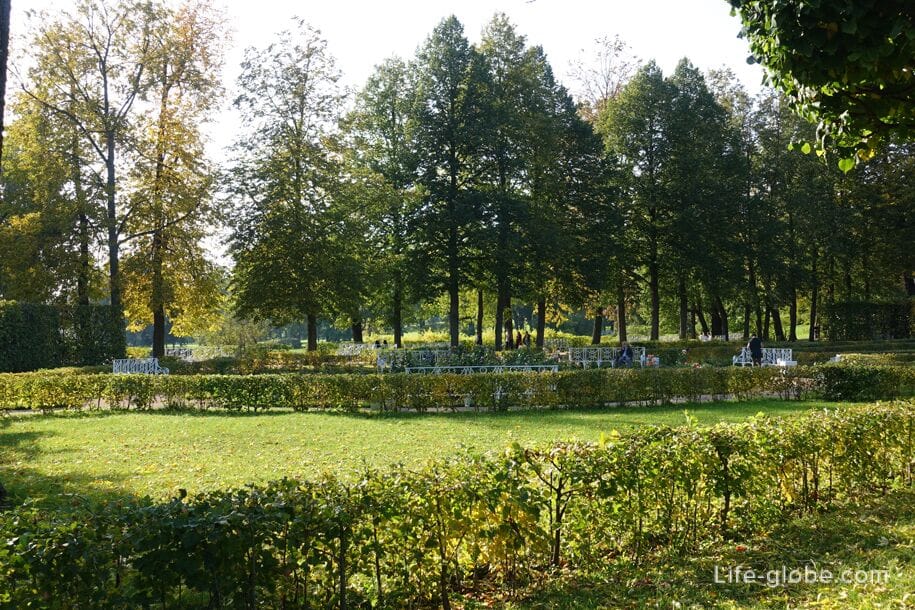
In this part of the Catherine Park there are such reservoirs as: Mirror ponds, Fish Channel, Channel of small cascades and Large cascade ponds. Canals and ponds cross and divide the bridges.
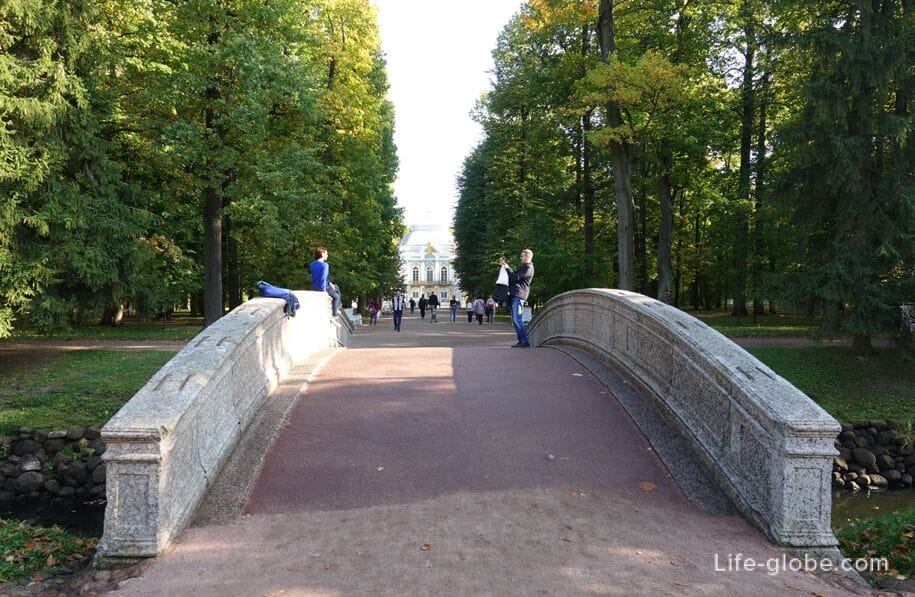



Pavilions of the regular part of the Catherine Park:
- The upper and Lower baths, which were originally used for washing and were called "Soapboxes".
The upper bath was intended for the imperial family (Their Highnesses) and was called "Their Highnesses 'Soapbox", and the lower bath was for the court gentlemen and ladies and was called "Cavalier Soapbox".
Currently, the Upper Bath Pavilion is used to house temporary exhibitions; and the Lower Bath Pavilion is open to the public with an exhibition called The Cavalier Soap House of the XXI Century. Learn more about the Upper and Lower Bath pavilions…
Photo of the Upper bath
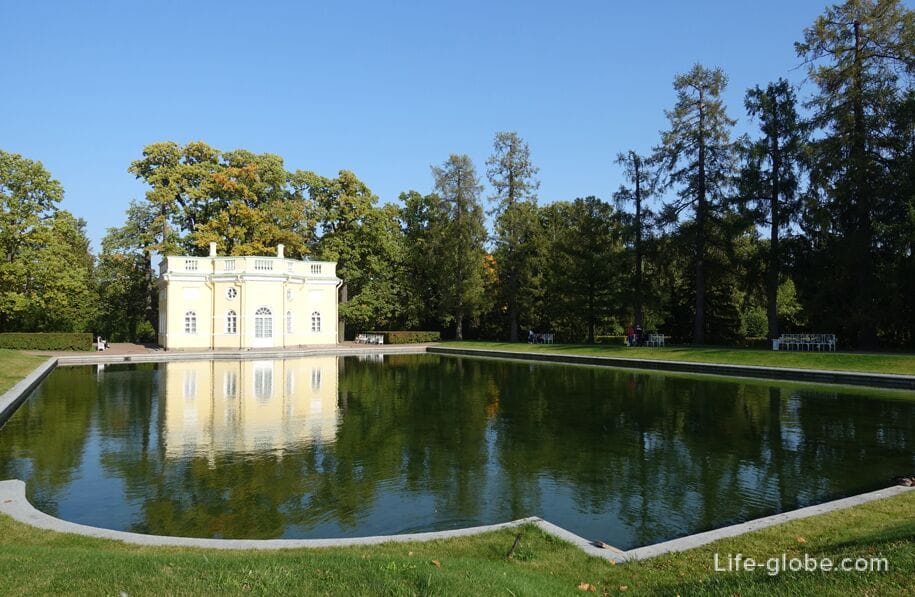
Photo of the Lower bath
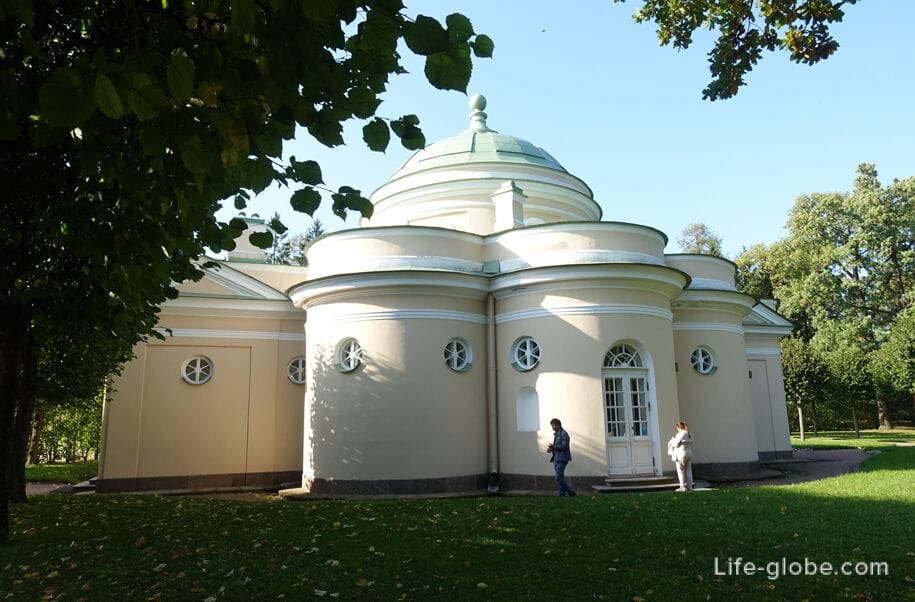
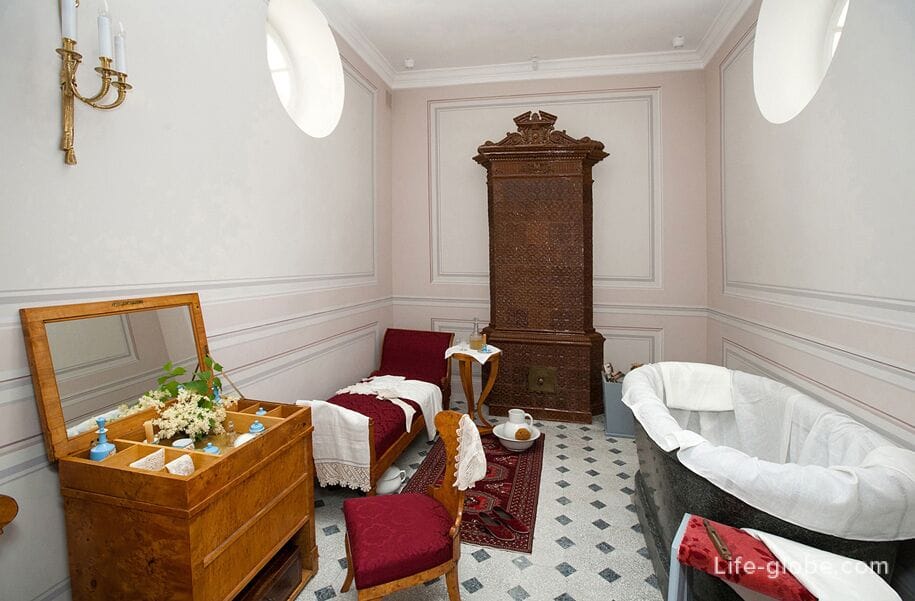
- the "Grotto" pavilion, which is located on the shore of a Large Pond and is made in the same Baroque style and color scheme with the Catherine Palace.
This pavilion is one of the most original and attractive structures of the park.
The pavilion is currently used for temporary exhibitions. More about the Grotto Pavilion…
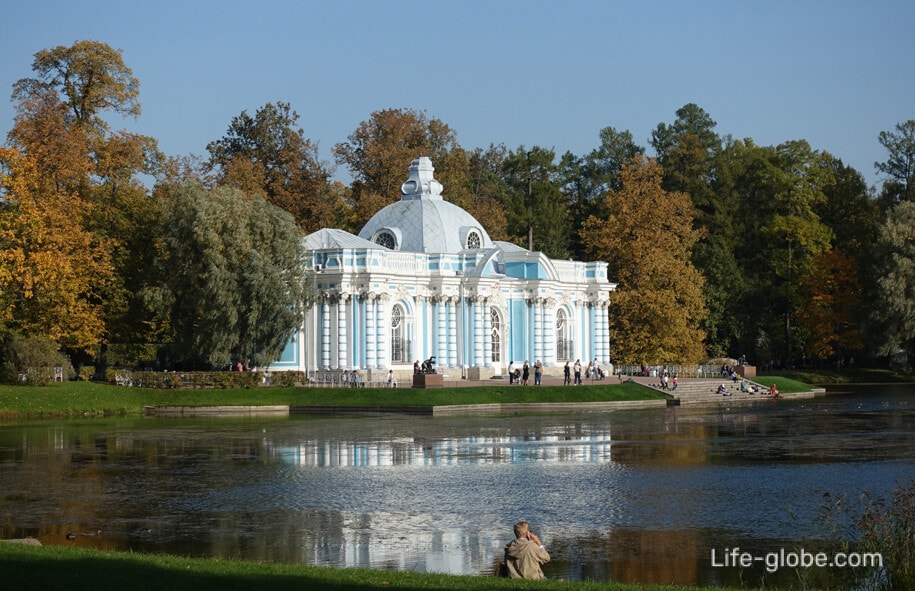
- the Hermitage Pavilion, which was intended for the recreation and dining of emperors and family members in a narrow circle of the elite.
The pavilion is located on an artificial island, lined with black and white marble slabs, which is surrounded on all sides by a canal and is fenced by a balustrade. You can get to the island to the pavilion via bridges over the moat.
The Hermitage Pavilion offers guided tours and temporary exhibitions. Open during the summer season. Learn more about the Hermitage Pavilion…

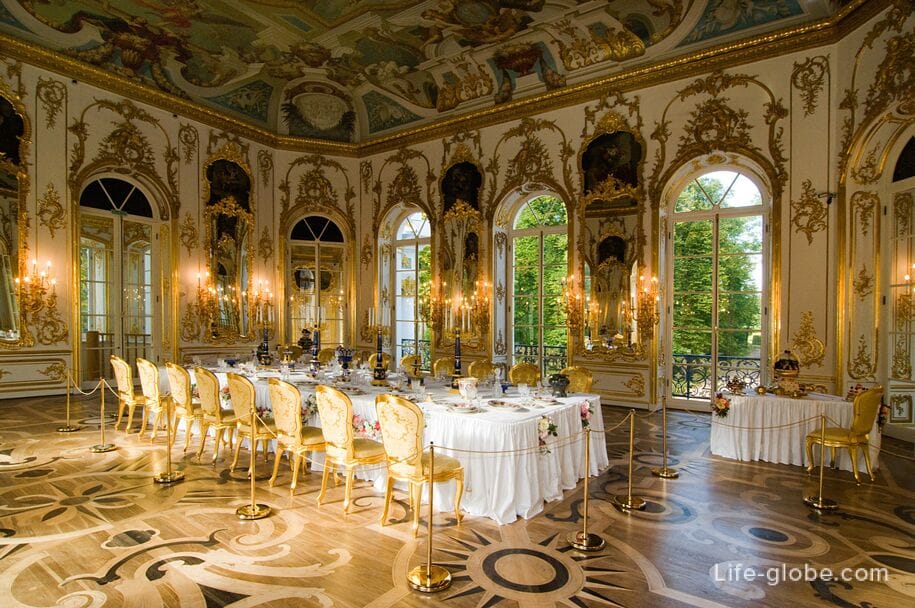
The park area near the Hermitage is designed as a quiet and secluded place for walking and isHermitage Grove.

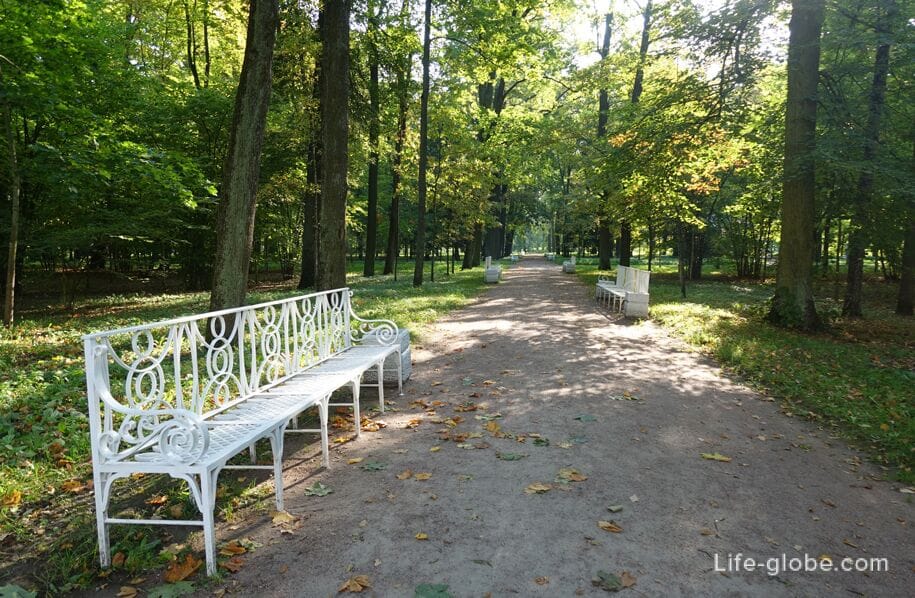
- The Hermitage Kitchen is a historical pavilion and the entrance gate to the Catherine Park.
The building served primarily as a kitchen for serving receptions held in the nearby Hermitage Pavilion. But, since the Hermitage kitchen was located at the fence of the regular part of the Catherine Park, it was built in such a way that it performed another function - one of the entrances to the park; from which it received its second name - "Red Gate".
Today, as before, the Hermitage Kitchen serves as the entrance gate to the park, and there is also a ticket office.
The pavilion houses a restaurant with the same name. Learn more about the Hermitage cuisine and restaurant…
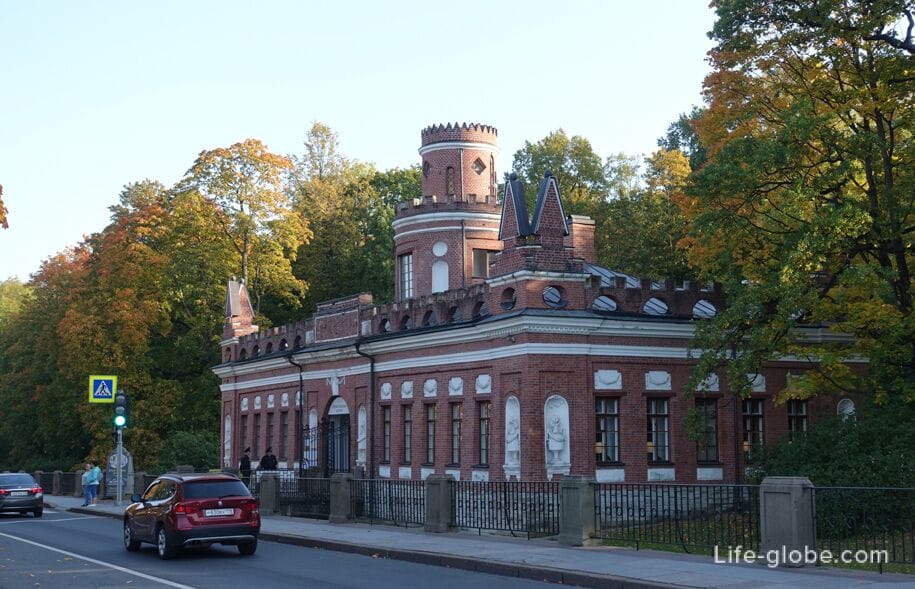
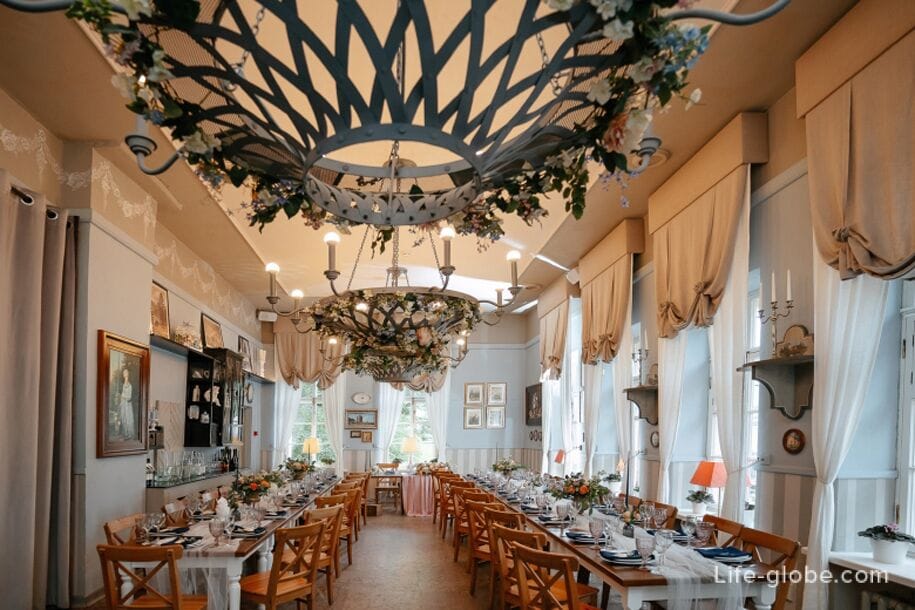
At the Green Bridge over the Great Cascade Ponds, there is a cast-iron gazeboinstalled for relaxing during walks in the park and decorating the park.
The roof of the gazebo with a fracture and a slight bend in the lower part rests on eight octagonal cast-iron pillars sunk into the ground.
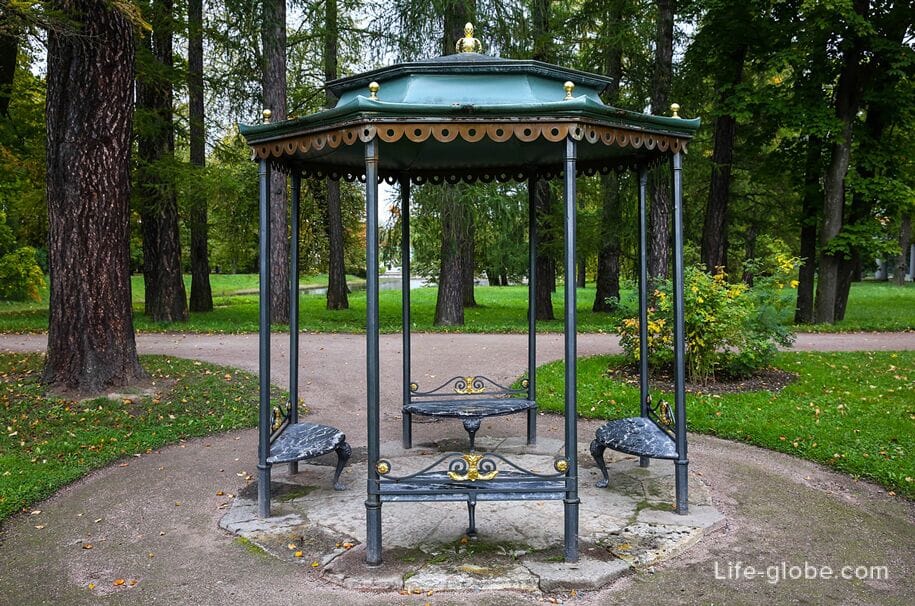
At the cascade between the First and Second Lower ponds is installedMoreyskaya (Small Rostral) column, which is a monument to the victories of Russia in the Russian-Turkish wars.
The column was erected in 1771 by the decree of the Empress Catherine II in honor of the victory of the Russian fleet under the leadership of Count F. G. Orlov at the Morea Peninsula in the Mediterranean Sea.
The height of the marble column is 7 meters. Its pedestal is set on a square platform, slightly rising above the ground. The column is completed by a small cone-shaped obelisk made of pink Tivdian marble, decorated with stylized prows of ships - rosters, reminding that the victory was won with the participation of the fleet.
On the pedestal of the Moray Column is a bronze plaque with a memorial inscription about the heroic battle.
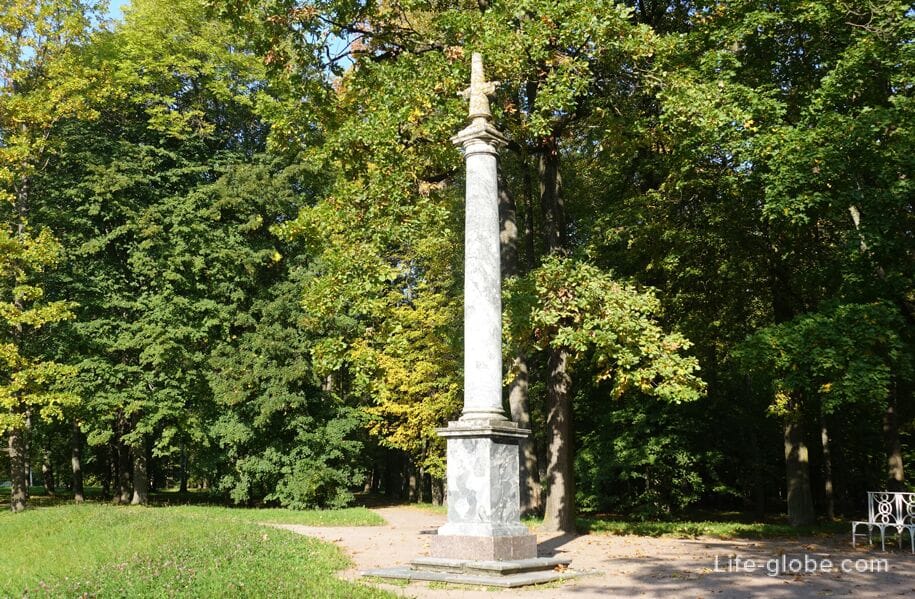
On the north-eastern edge of the park stands the monumental triumphal cast-iron gate "To my dear colleagues".
The gate was built by architect V. P. Stasov in 1817 in honor of the victory of Russia in the Patriotic War of 1812. On the gate are placed the words: "To my dear colleagues", which belong to the Emperor Alexander I.
The gate consists of four pairs of cast-iron Doric columns with a height of 5.7 meters, which support a heavy entablature.
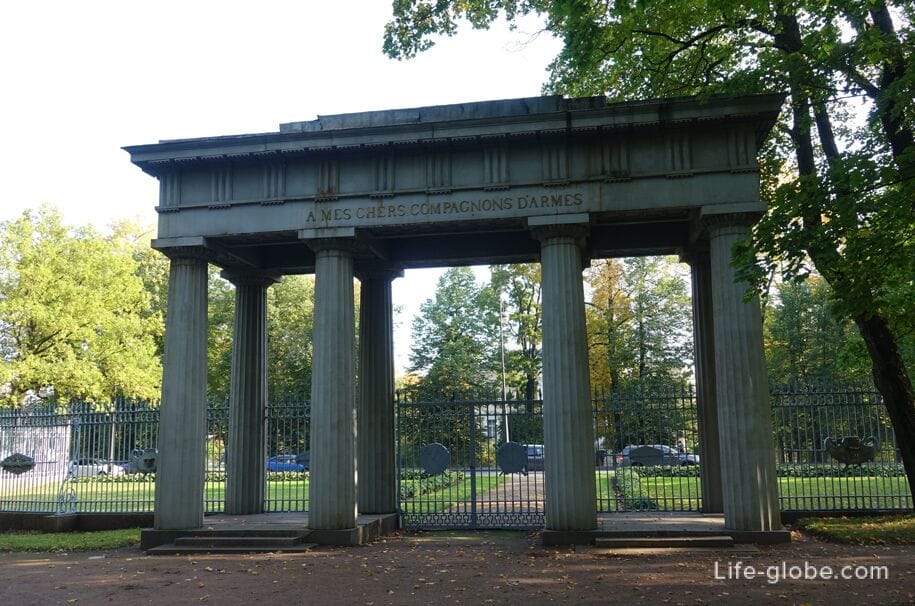
The landscape part of the Catherine Park stretches to the south of the palace and the regular part of the park.
This part of the park occupies a larger area of the entire park and has a more natural ("living") appearance.
There are places for walking and recreation, pavilions and monuments, fountains, meadows, ponds and canals crossed by bridges.
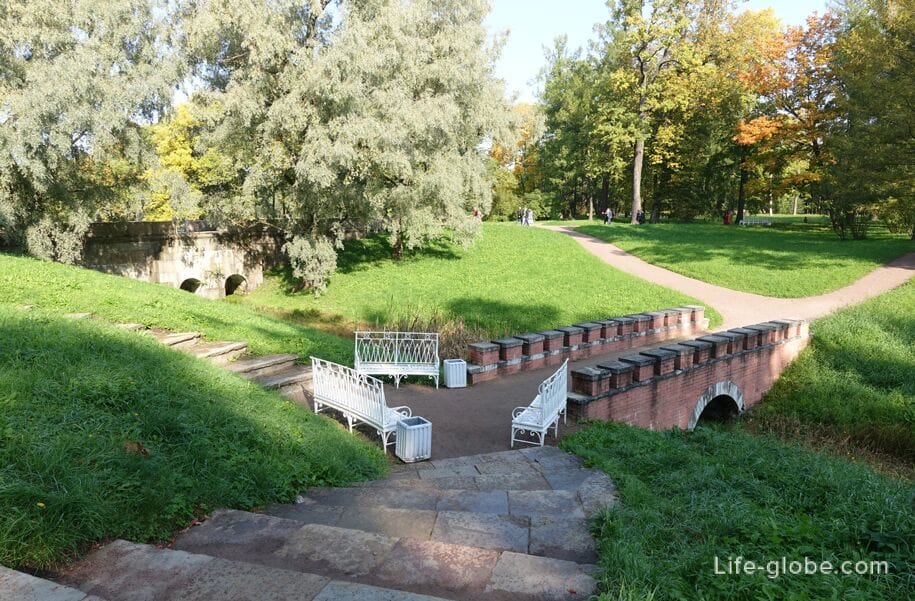

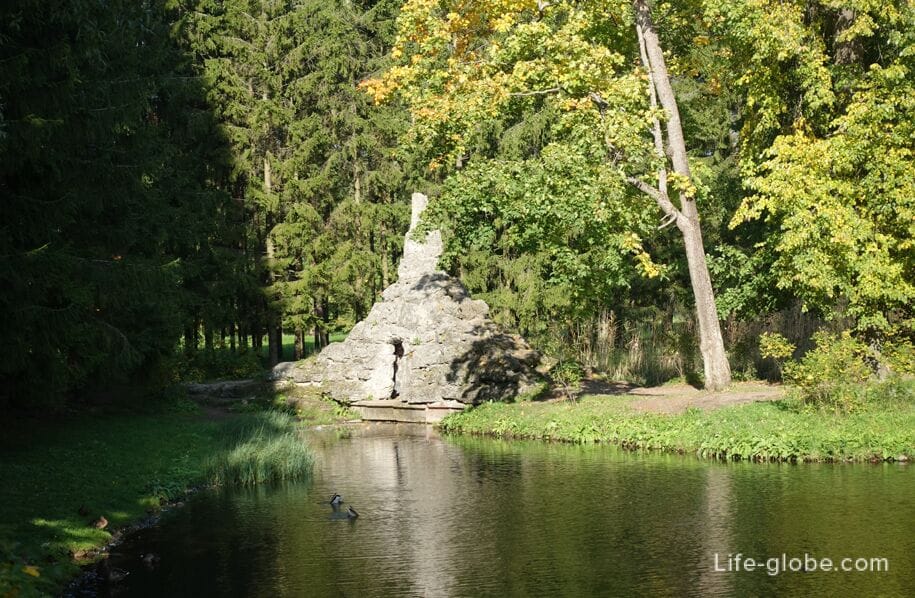

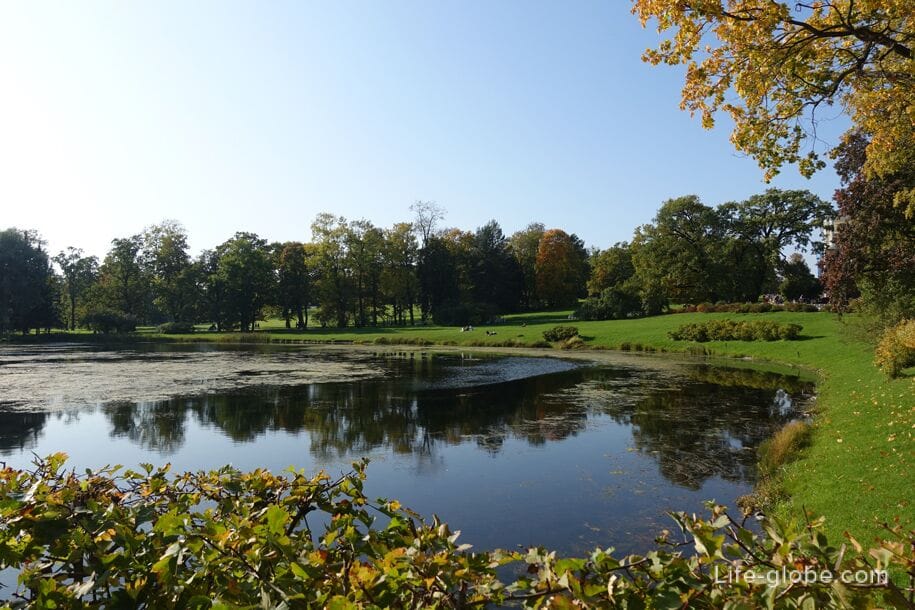
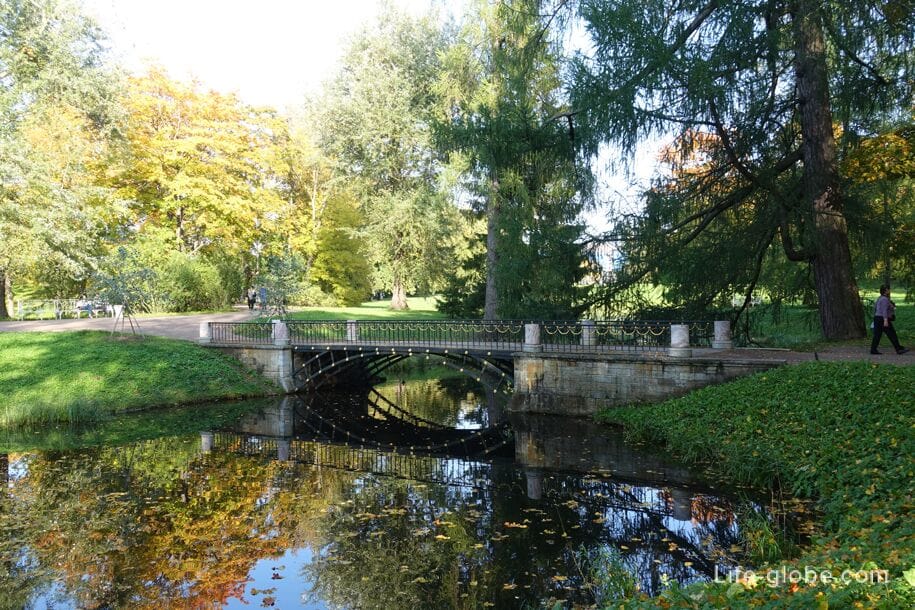
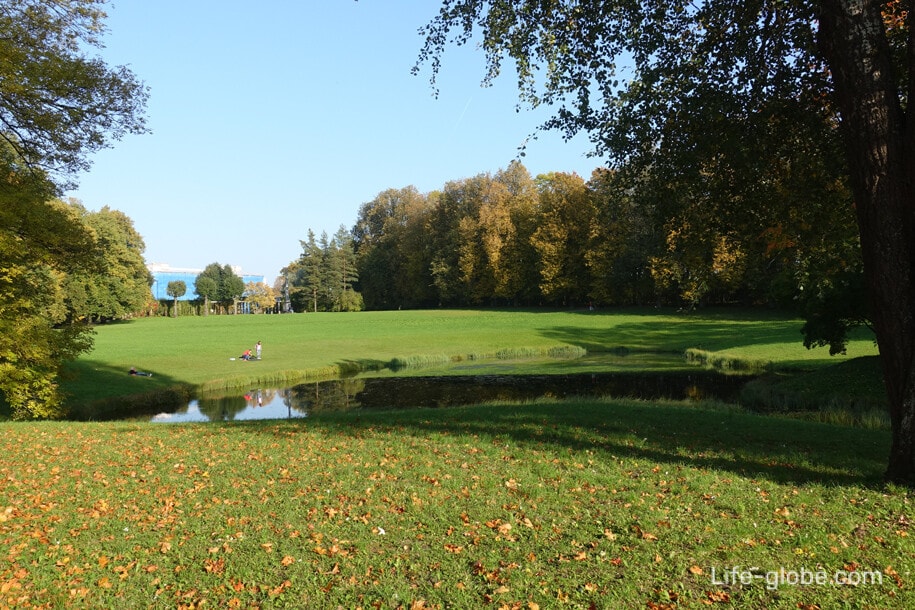
The compositional center of the landscape part of the Catherine Park isA large pondthat was dug in the early 18th century. Pavilions, buildings, and wharves were erected around the pond. You could go boating on the pond. Learn more about the Bolshoy Pond Ensemble…
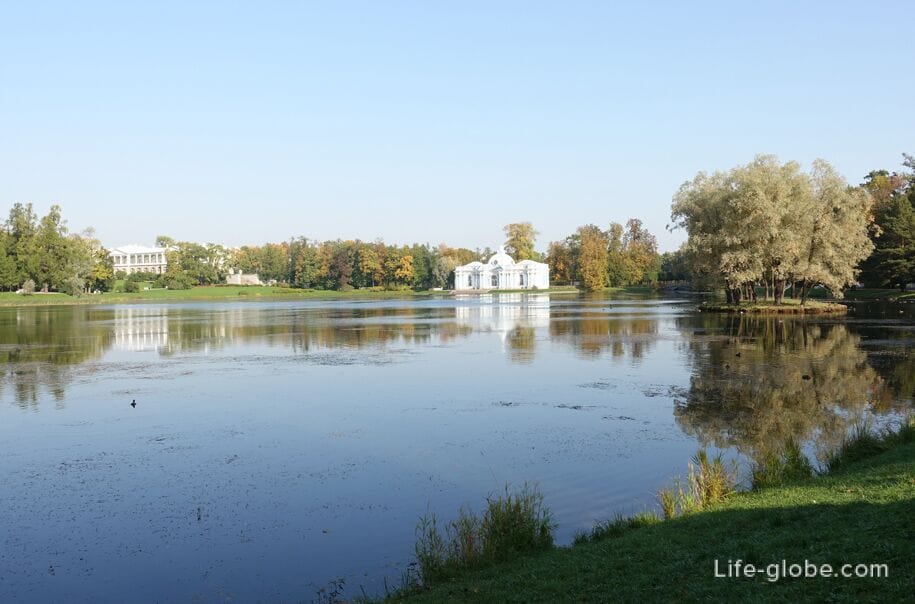
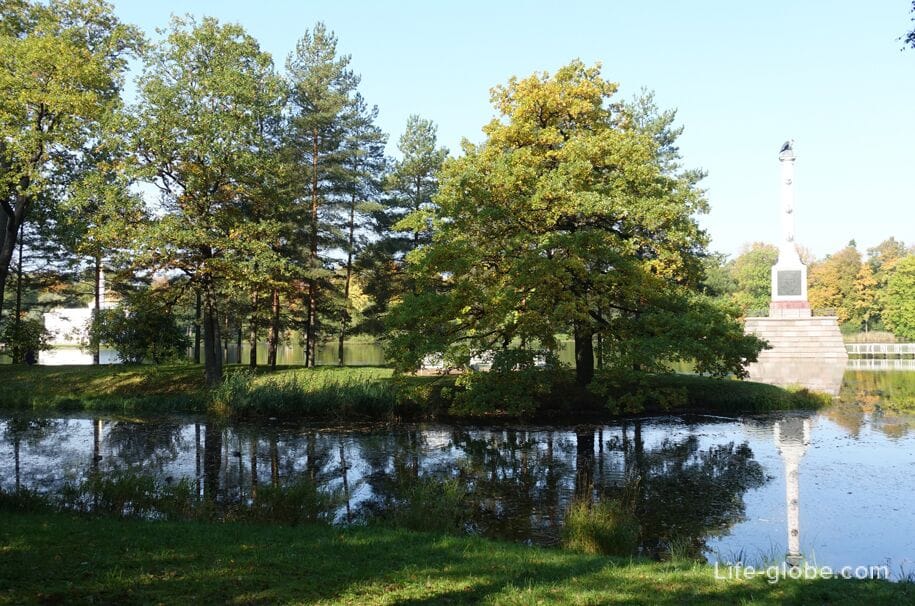

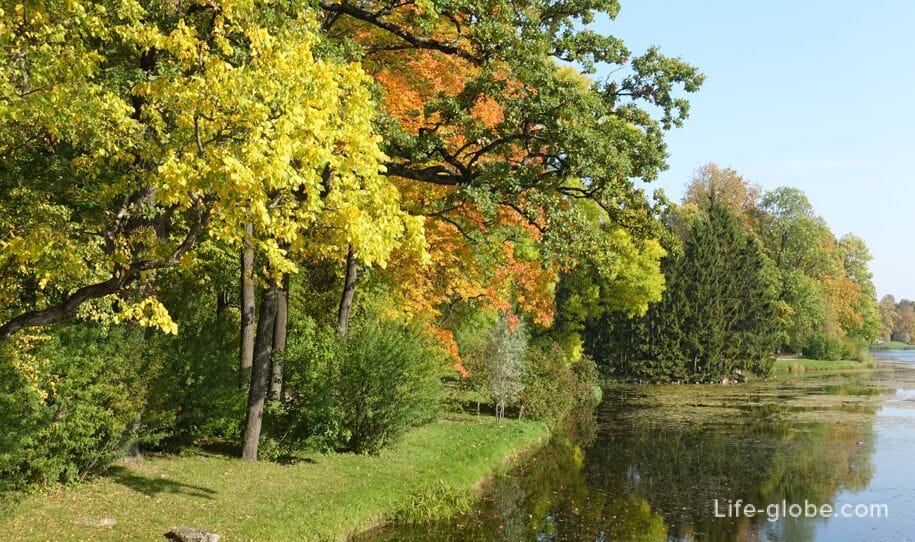
In the center of the Large Pond is the marble Chesma Column (Oryol Column), which was built in 1774-1778 by the Italian architect Antonio Rinaldi and is one of the monuments-memorials erected in honor of the three victories of the Russian fleet during the Russo-Turkish War of 1768-1774: the Chios, Chesma and Mytilene battles.
Bronze bas-reliefs depicting historical naval battles are placed on three sides of the gray marble pedestal of the Chesma column. On the south side, a marble plaque is attached to the pedestal with a description of the history of the immortalized battles.
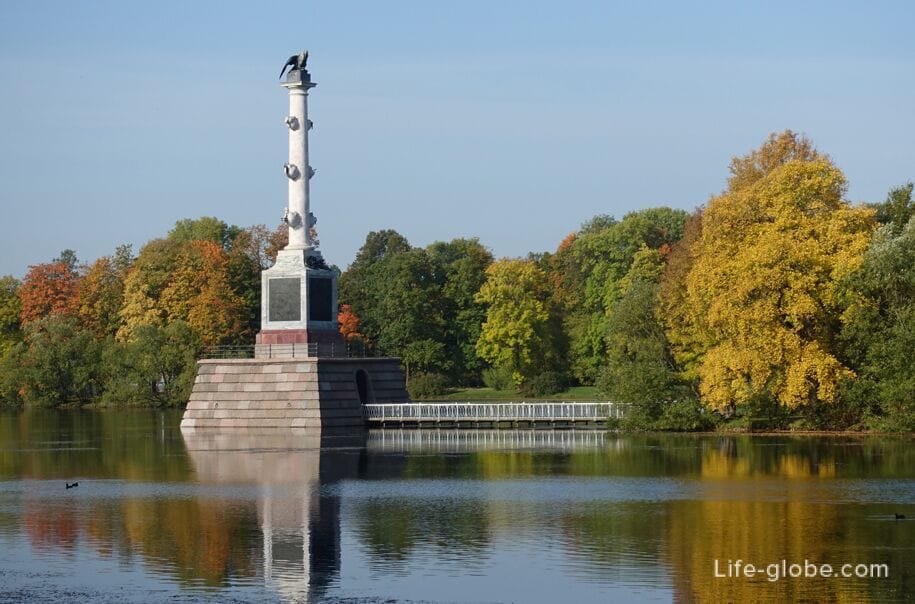
A bridge leads from the column to the island in the Big Pond. On the island itself is the pavilion "Hall on the Island", originally built in the late 1740s according to the project of S. I. Chevakinsky and decorated according to the sketches of F.-B. Rastrelli.
In the 18th and early 19th centuries, the pavilion was used for concerts and recreation, boating on the pond, and occasionally held court dinners in the pavilion.
Today, the Hall on the Island pavilion is used in the summer for concerts and special events. Read more about the Chesma Column and the Hall on the Island pavilion»…
You can only get to the island and the Chesma Column by ferry for a fee.
Ferries depart from the piers on the banks of the Big Pond, located near the Admiralty (east bank of the pond, ticket office in the Admiralty building) and near the fountain "Girl with a Jug" (west bank of the pond).
From the pier at the Admiralty, you can take a ride on the pond in a Venetian gondola.
Photo of the pier at the Admiralty
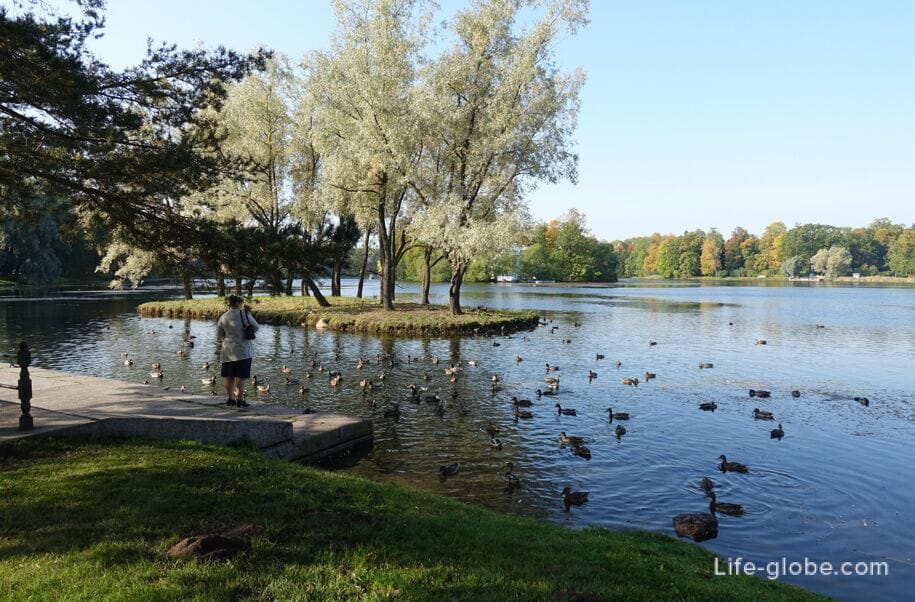
Photo of the pier near the fountain " Girl with a jug»
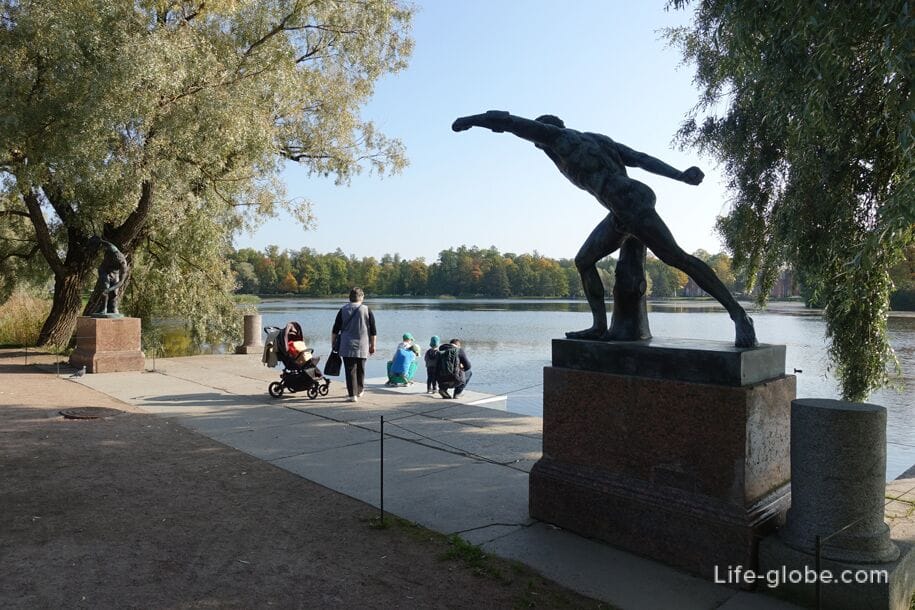
On the south-western side of the Large Pond is a monumentalThe marble Bridgethat separates the Big Pond from the Swan Ponds, on which an archipelago of 7 islands was created, where small houses for swans were previously located.
The marble bridge is a magnificent monumental colonnade, set on a granite base, with wide staircases radiating on both sides. Learn more about the Marble Bridge…

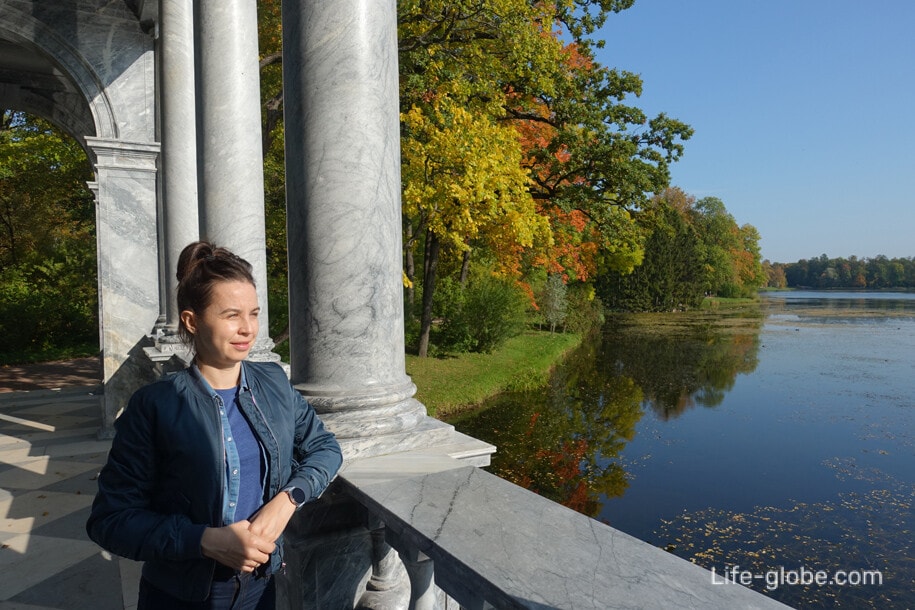
Around a large pond in the landscape part of the park are located:
- Admiralty, which is an architectural ensemble consisting of three historic garden and park pavilions, made in the Dutch style.
The complex was built in 1772-1775 by the architect V. I. Neelov.
Today, the central building of the Admiralty is used for temporary exhibitions, and one of the two surrounding buildings, which were previously Poultry Houses, has a restaurant.
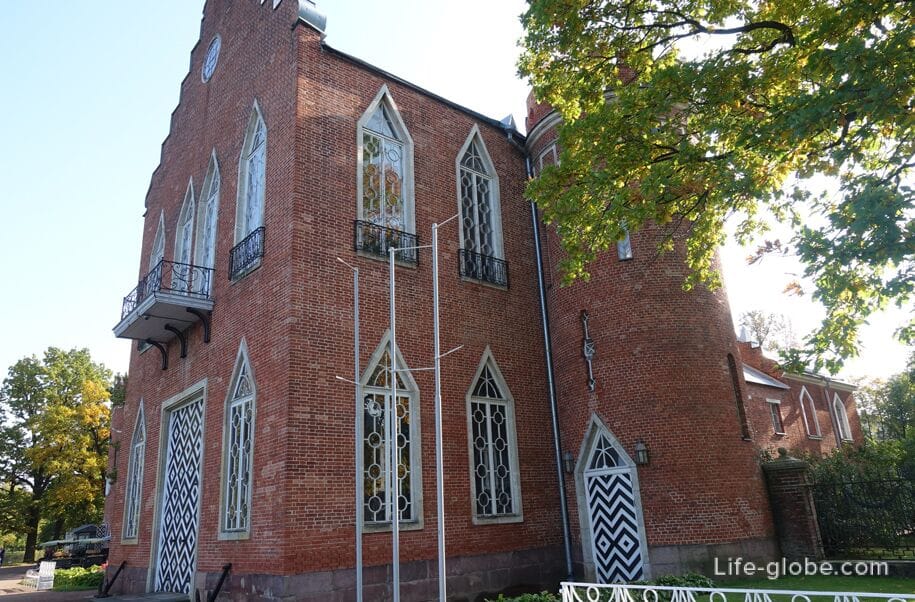
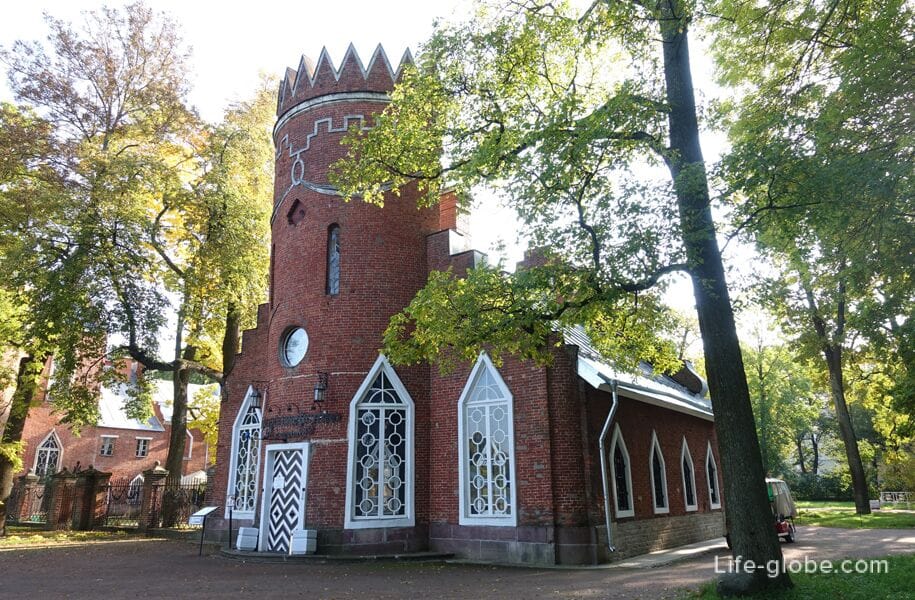
From the Admiralty, for a fee (the ticket offices are located here), you can take a tour of the landscape part of the Catherine Park in electric cars. You can also take a ride in a horse-drawn carriage in the park. Learn more about the Admiralty…
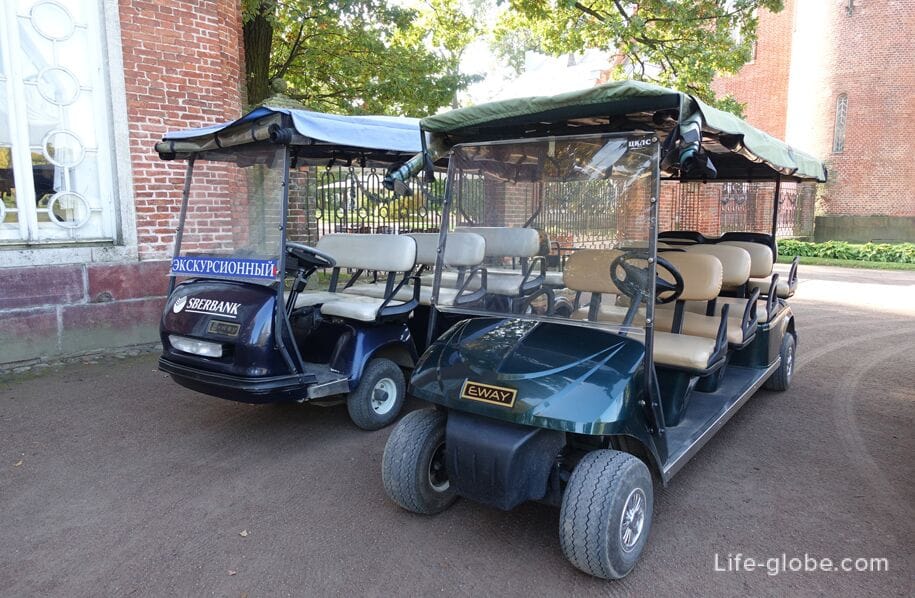

- the Turkish Bath pavilion, built in 1850-1852 by the architect I. A. Monighetti, by order of Emperor Nicholas I.
The Turkish bath was a kind of memorial erected in honor of the victory in the Russian-Turkish War of 1828-1829. The Turkish mosque was used as a model for the construction of the memorial pavilion.
The interiors of the Turkish bath are made in the "Moorish" style.
The Turkish bath was previously intended for washing and relaxing.
Today, the Turkish Bath is a museum that can be visited for a fee. The ticket offices are located near the entrance to the pavilion. Learn more about the Turkish Bath Pavilion»…

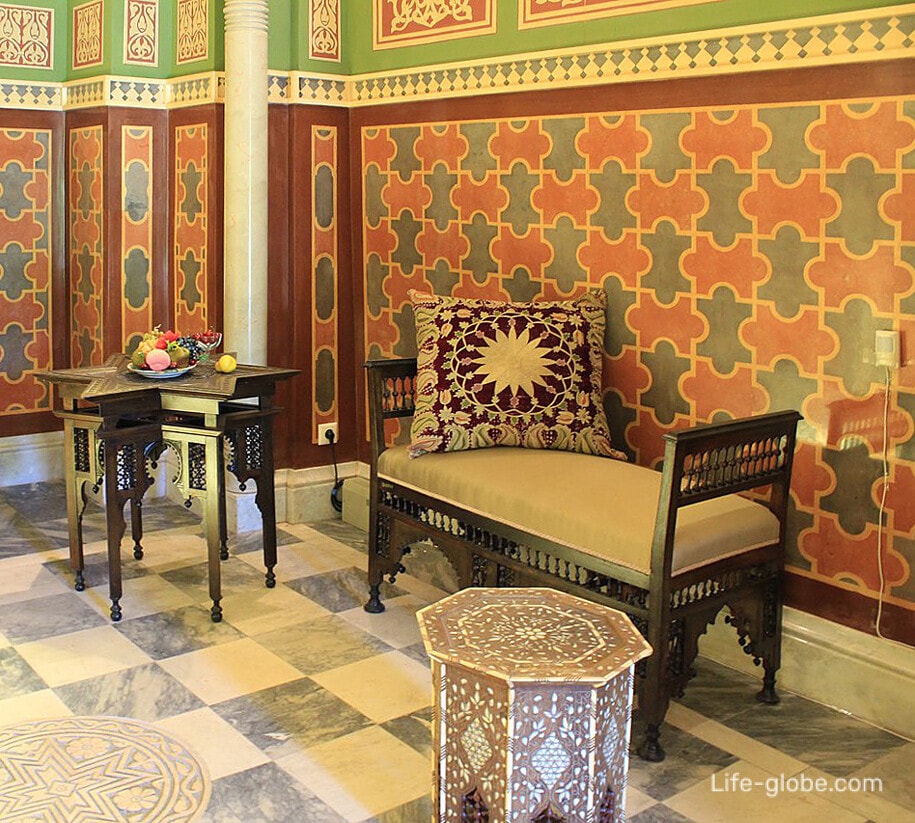
- a fragment of the original bronze bas-relief of the Chesma column, which is located in a Large pond.
The column was damaged during the Great Patriotic War, and after its fragment was found at the bottom of the pond.
The bas-relief depicts the naval battles of the Russian-Turkish War of 1768-1774;
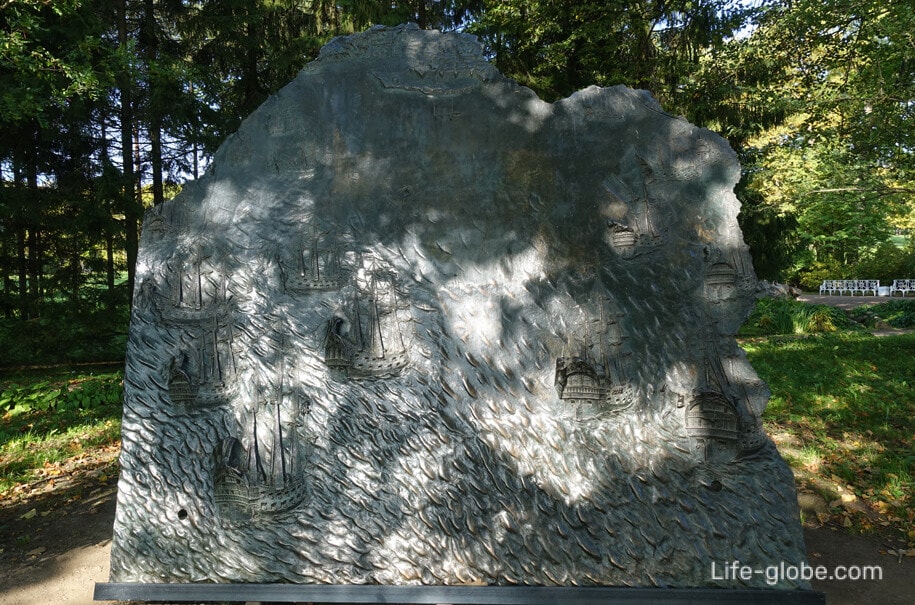
- the fountain "The girl with the Jug", arranged on the embankment, under which the waters of the local spring are hidden.
The fountain was designed by the engineer A. Betancourt and is a granite rock, which is a pedestal on which in 1816 was installed the sculpture "Girl with a jug", made by the sculptor P. P. Sokolov. Today, a copy of the sculpture, cast in 1990, is installed in the park, and the bronze original of the " Girl with a Jug "is placed in the funds of the museum-reserve"Tsarskoe Selo".
The sculpture represents a young girl sitting on a large boulder and fixing her eyes on a broken jug lying at her feet. From the pitcher runs a stream of spring water, descending the steps of the fountain, and then along the channel into a Large pond. Read more about the fountain " The Girl with the Jug»…
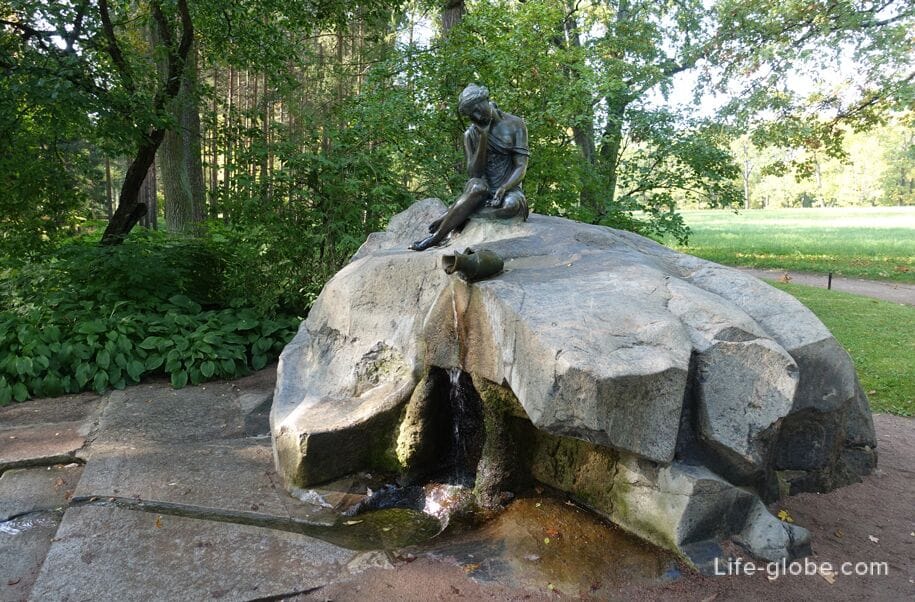
- decorative parterre with flower beds, sculptures (Venus and Cupid, Imperial Nerve) and alleys.
The ground floor was designed by architect T. B. Dubyago, developed in the 1950s.
Below the stalls, near the banks of a Large pond, there is a granite pier. And above - a monumental Granite terrace with stairs and a balustrade decorated with electroplated copies of ancient sculptures - "Venus de Medicea", "Faun with a kid", "Apoksiomena", etc.Learn more about the Granite Terrace, parterre and marina…

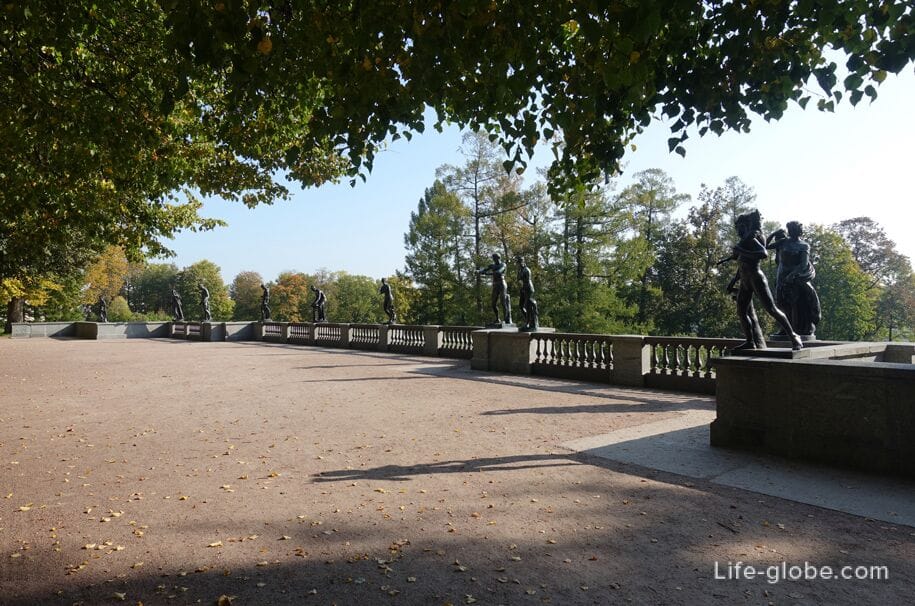
- the monument is a copy of the bust of Tsarevich Nikolai Alexandrovich, installed on a high pedestal.
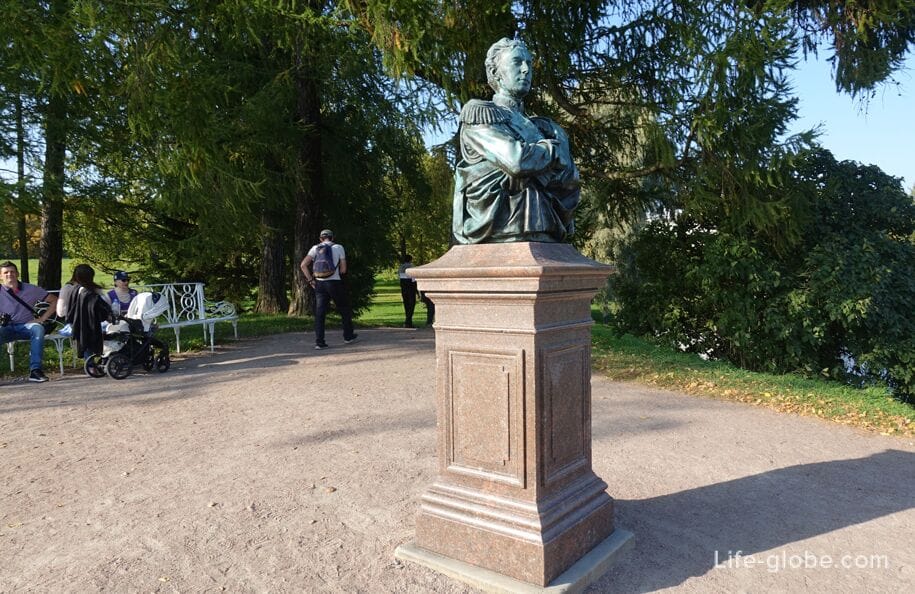
Pyramid
The pyramid is a small building (pavilion), which is something like a mausoleum and was originally built in 1770-1772 by the architect V. I. Neelov. In 1774, the Pyramid was dismantled, and in 1782-1783 it was rebuilt by the architect Charles Cameron.
The walls of the pyramid are built of brick and lined with hewn granite on the outside.
On one side of the pyramid, an entrance cuts through; and on the opposite side, at the foot of the Pyramid, three of Catherine II's favorite dogs are buried: Tom Anderson, Zemira and Duchess. Learn more about the Pyramid…
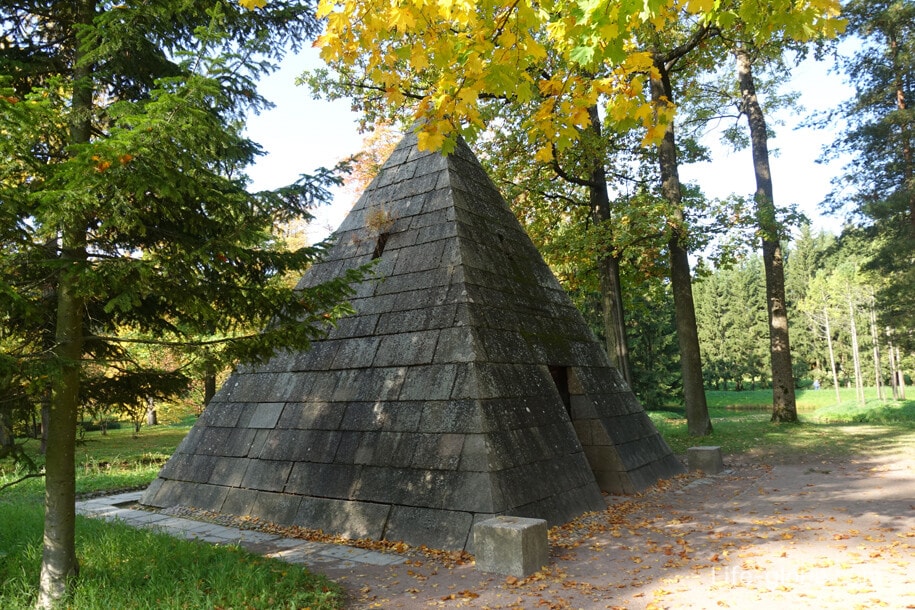
Gothic Gate
The Gothic gate is the decoration of the park. They were cast in Yekaterinburg in 1777-1778 according to the project of Yu. M. Felten. The drawing of the gate was borrowed by the architect from the English album Gothic Architecture Decorated, known in Russia already in the 1760s.
The hexagonal pedestals of the gate are worked with panels with Gothic ornaments. High columns in the form of six-leafed columns form openwork abutments connected by a "Gothic" arch. Cast-iron sculptural figures of virgins are installed between the columns.


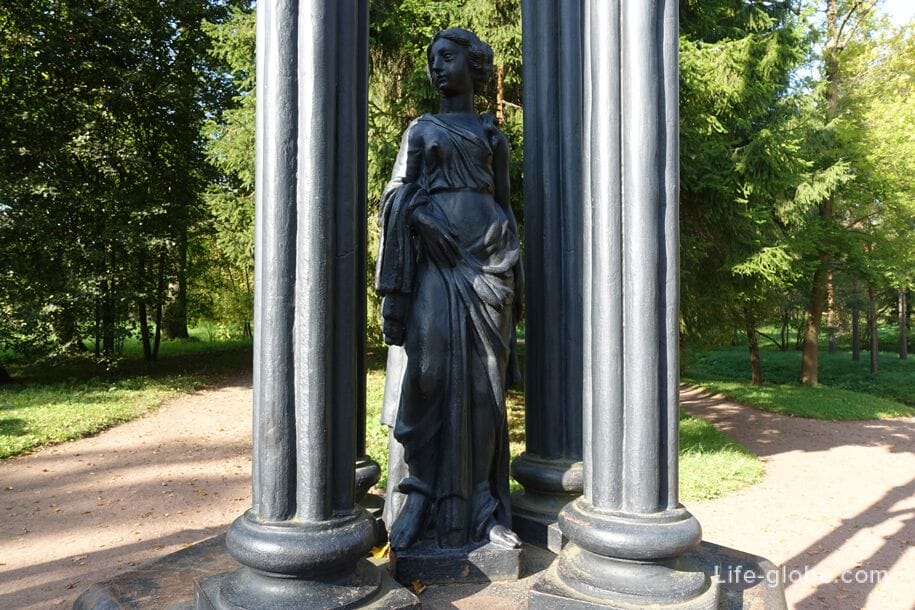
The tower is a ruin
The tower-ruin is located in the southern part of the park on a small artificial embankment. It was built in 1771-1773 by the architect Yu. M. Felten, at the behest of the Empress Catherine II.
The tower is one of the memorial architectural structures dedicated to the Russian-Turkish wars. This is a kind of symbol of the fall of the Ottoman Porte.
The monument is a small semblance of the remains of an ancient Turkish fortress, consisting of a tower and an adjacent part of the fortress wall with a system of defense devices that are artificially aged and partially hidden in an earthen embankment. The tower itself is crowned by a gazebo, which was once one of the first Russian park buildings in the "Gothic" style.
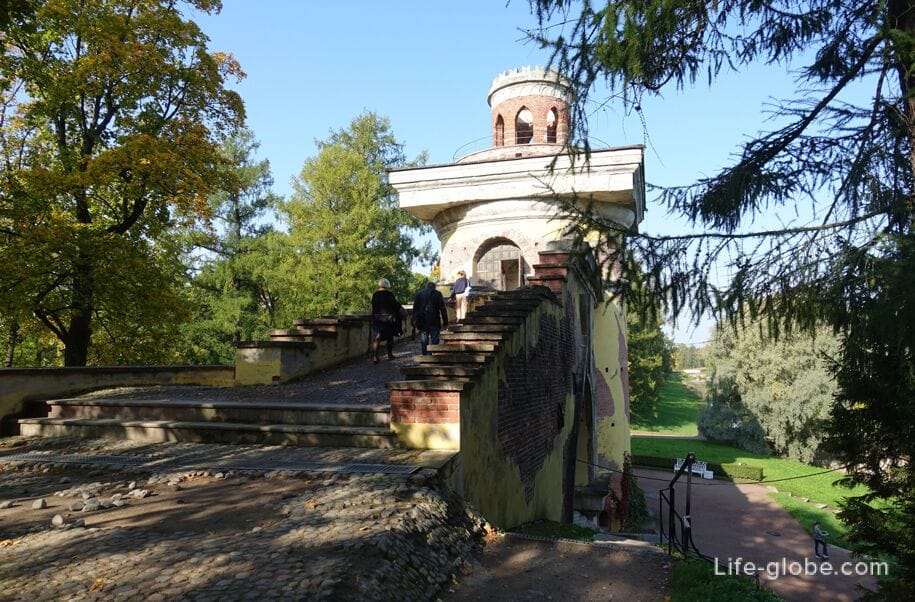
The tower-ruin can be climbed and today it is also a popular viewing platform of the Catherine Park.
In the tower there is a spiral ramp, which allows you to climb to the top platform of the tower, located at a height of 21 meters. Learn more about the Ruin Tower and the observation deck…
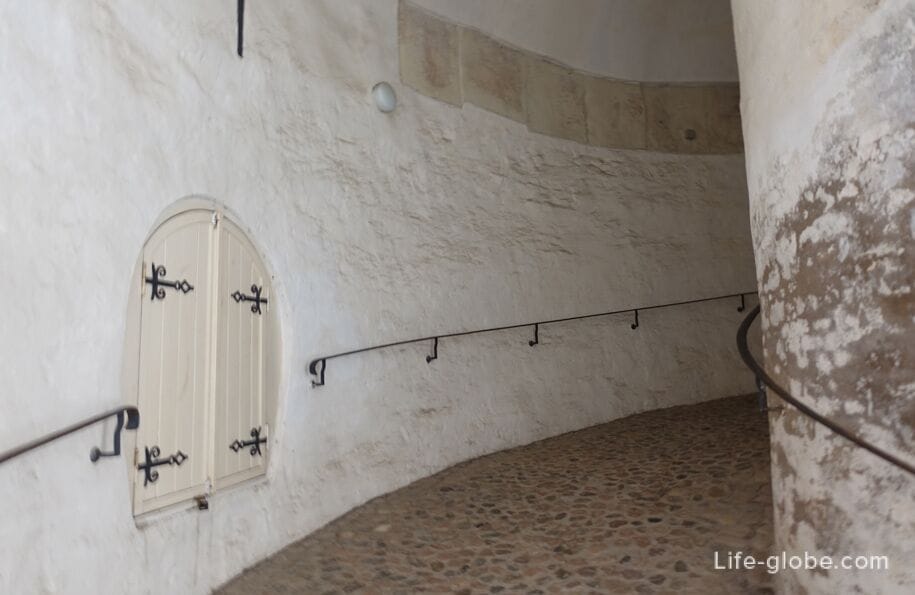
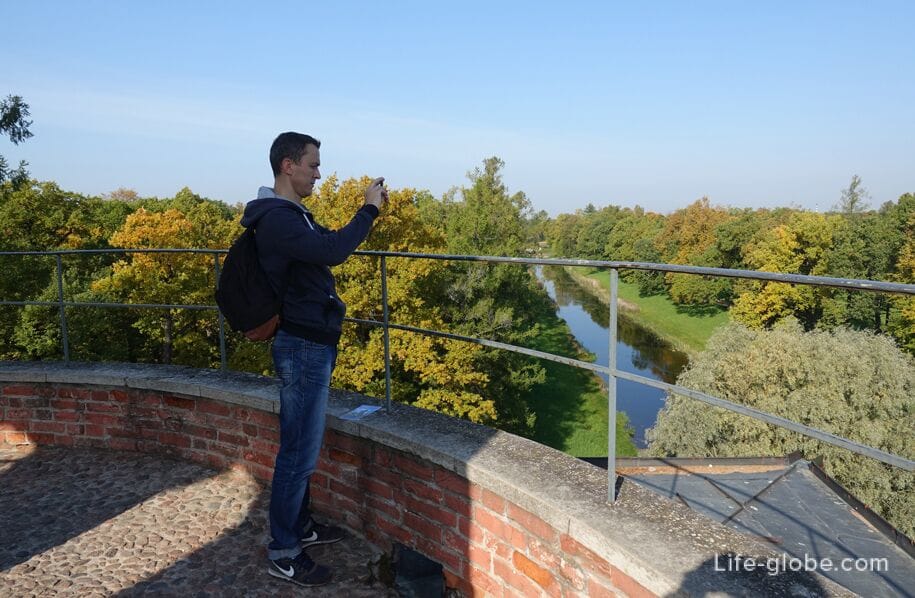
Orel Gate
Orel (Gatchina) Gate - one of the gates of the Catherine Park, erected at the exit to the road leading to Gatchina, to commemorate the victory over the plague in Moscow, the fight against which was led by the revered favorite of Catherine II-G. G. Orlov.
The gate is made in the form of a single-span triumphal arch and has a height of about 15 meters. Learn more about the Orel Gate…
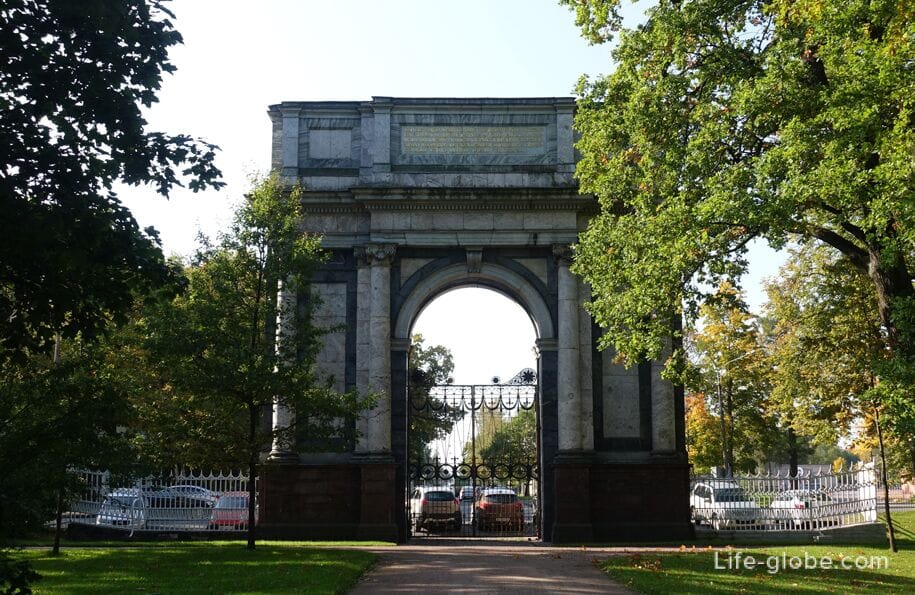
Red Cascade
The Red Cascade is one of the dams installed on the Upper Ponds of the park, which were dug in the early 1770s and communicated with the Large Pond. The water flowing freely down the hill towards the pond began to wash out the hollow, and in order to prevent the Upper Ponds from drying up, it was decided to create a system of dams on the channel.
The construction of the dams was carried out by engineer I. K. Gerard. Today, a number of his projects of dams-cascades, which allow to maintain a constant water level in the Upper Ponds, have been preserved.
Among the works carried out, a special place is occupied by the Red Cascade (or Turkish Cascade), which is a dam with two tapering "Gothic" towers on the sides. The walls of the towers are made of red brick, treated with niches with pointed ends. Narrow slits-loopholes in the niches and a crenellated parapet give the cascade the appearance of a peculiar small fortress structure.
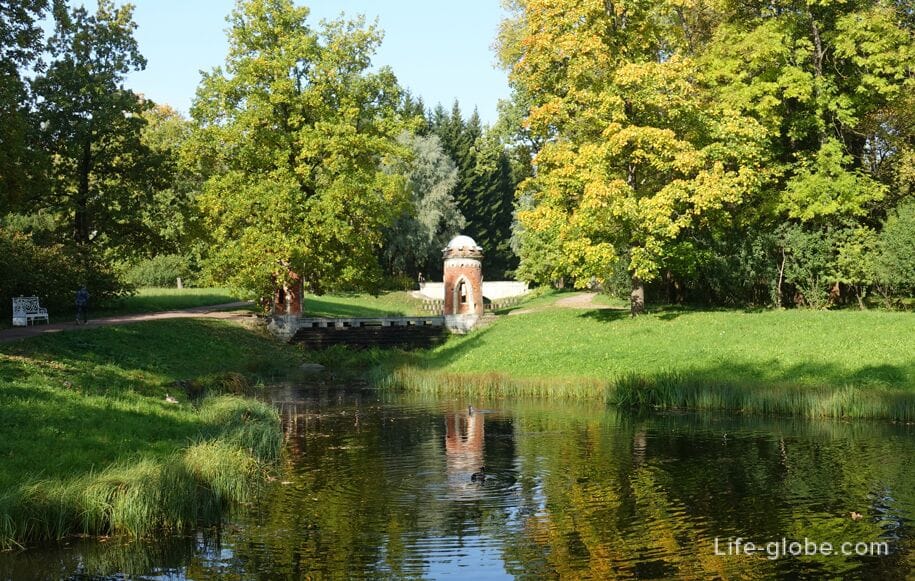
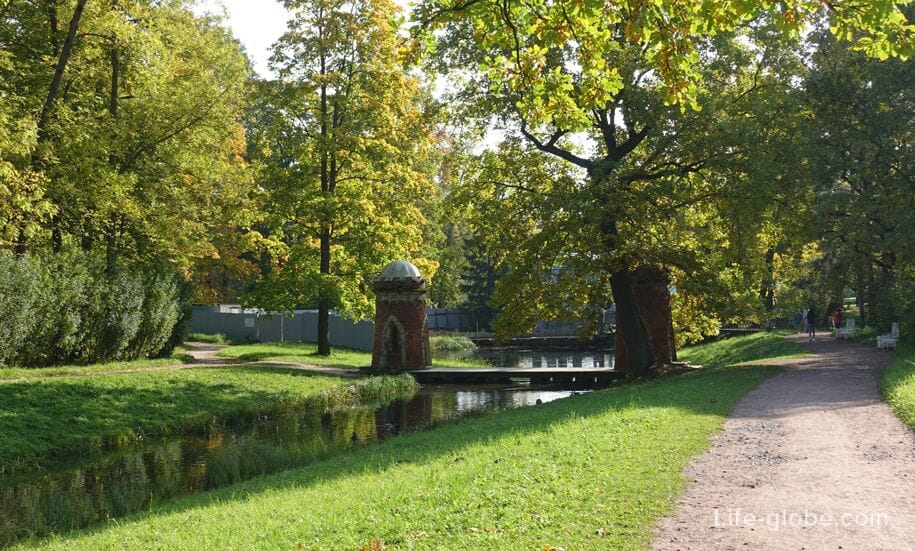
Monument to A. D. Lansky
The monument to A. D. Lansky is perhaps the most unusual of the monuments of the Catherine Park.
The monument is a vase with the completion in the form of a tongue of flame, mounted on a high pedestal.
This structure is usually called the monument to A. D. Lansky-a favorite of the Empress Catherine II. However, in archival documents, the monument is called a "Marble Pedestal" and is characterized as an allegory of "virtues and merits", not associated with a specific historical person. Three sides of the pedestal were decorated with bas-reliefs of white marble depicting a wreath, a shield with a spear suspended from a ribbon, and a cornucopia. And, along with the symbols, on the side of the pedestal facing the palace, a bronze plaque was installed with the inscription: "Since it is a great pleasure for honest souls to see virtues and merits worthily crowned with common praise"; above the inscription, it was placed a relief gilded coat of arms of Lansky and an image of two sides of a medal stamped in his memory (hence the attribution of the monument to A. D. Lansky).
Today, the monument has been restored and is made of white, pink and gray marble.

Concert hall
The "Concert Hall" pavilion was built in 1782-1788 by the architect Giacomo Quarenghi, who described the structure as "a hall for music with two offices and an open temple dedicated to the goddess Ceres".
The interior of the Concert Hall has a large hall and two offices, decorated with a variety of decorative finishes.
The Concert Hall pavilion is open to visitors in the summer. Entrance is paid. Learn more about the Concert Hall…
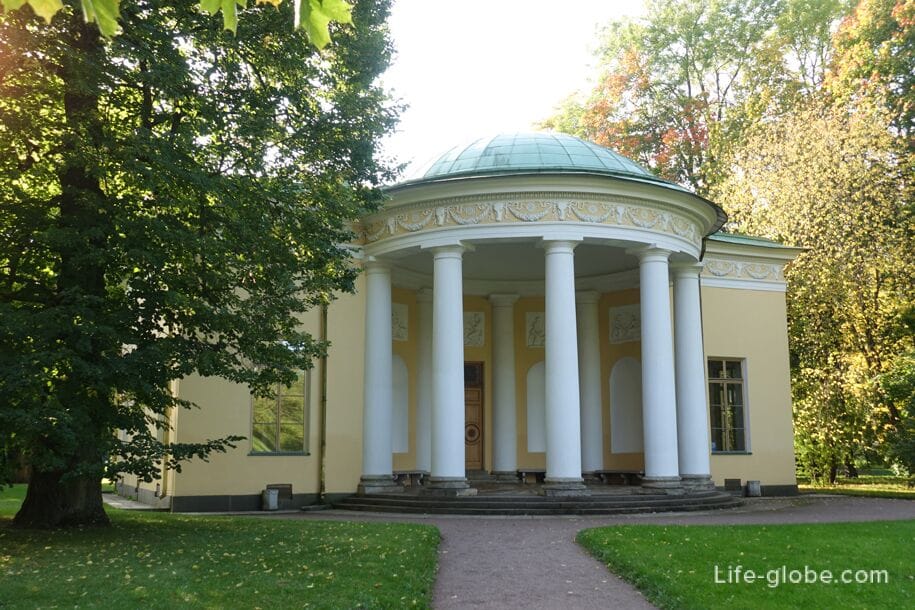

Kitchen-ruin
Next to the pavilion "Concert Hall" there is a detached structure-a Kitchen-ruin, which was built to warm up meals for the guests of the Concert Hall and looks like an old ancient monument. However, the pavilion was aged initially and on purpose. Learn more about the ruin kitchen…
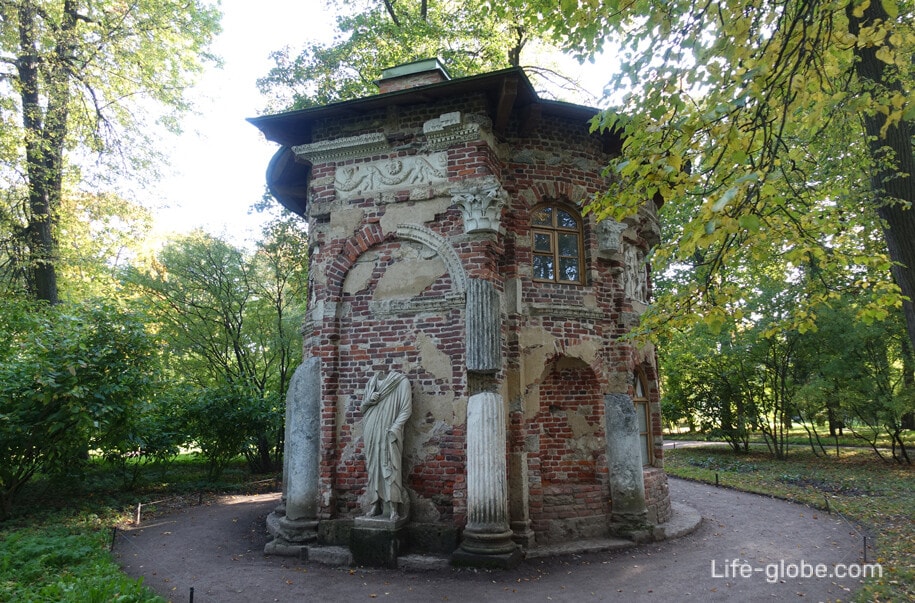
Creaky gazebo
The Creaky Gazebo or Chinese Gazebo is perhaps the most exotic pavilion in Catherine Park.
The name" Creaky", the gazebo received due to the fact that the weather vane in the form of a Chinese banner, installed on the roof of the pavilion, when rotating in the wind, makes a creak. And "Chinese" - thanks to its appearance.
The gazebo was built in 1778-1786 under the direction of I. V. Neelov, designed by architect Yu. M. Felten, under the Empress Catherine II, who was fond of Chinese culture.
The creaky gazebo is open to visitors in the summer. Learn more about the Creaky Gazebo…
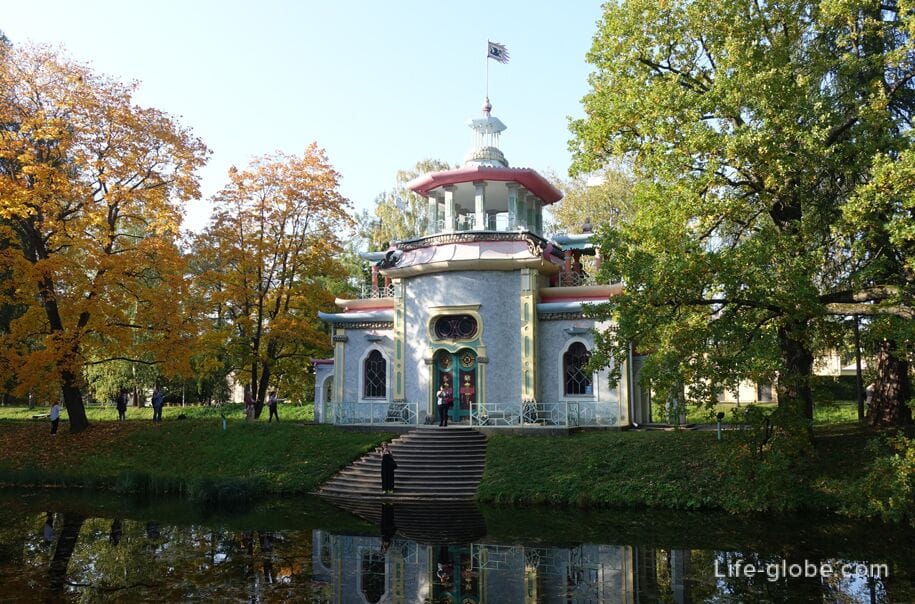
Evening Hall
The pavilion "Evening Hall" was built starting in 1796 by the architect P. V. Neelov. The construction was completed in 1810-1811 according to the drawing of the architect L. I. Rusk.
This small one-story building is designed in the style of late classicism.
In the external architecture of the pavilion, attention is drawn to the central risalit of the main facade, decorated with a portico of four Ionic columns, which ends with a small pediment, as well as caryatids installed on the sides of the windows on low pedestals.
The evening hall consists of a rectangular hall and two small offices.
Today, the pavilion is used as a concert hall. Learn more about the Evening Hall…
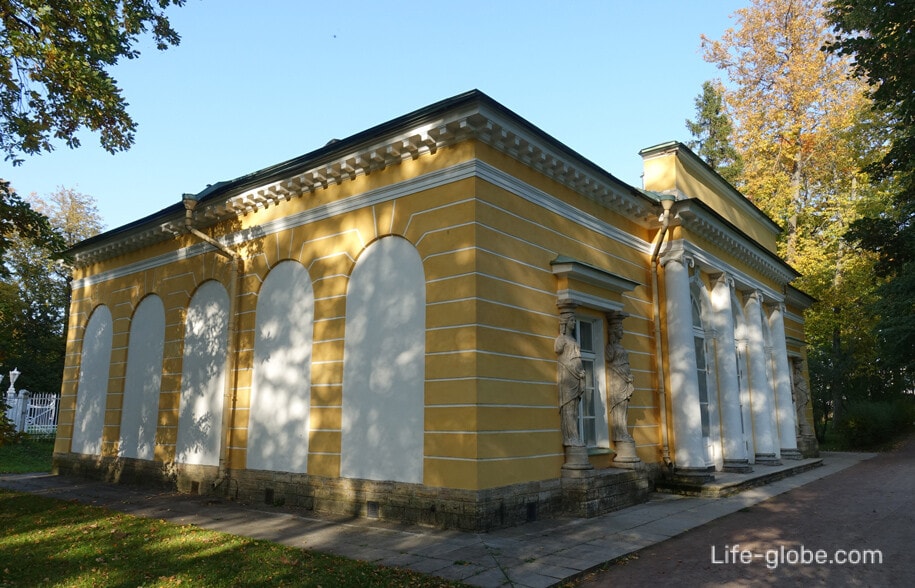
Cahul Obelisk and Private garden
The Cahul Obelisk (Rumyantsev Obelisk) and its Own garden are located close to each other and together represent an ensemble located near the southern facade of the Catherine Palace.
Russian Russian troops under the command of General Count P. A. Rumyantsev (hence the second name of the obelisk - "Rumyantsevsky") over the Turks in the battle on the Cahul River, during the Russo-Turkish War of 1768-1774.The Cahul obelisk in the forms of classicism was erected in honor of the victory of the Russian troops under the command of General Count P. A. Rumyantsev.
The obelisk was built in 1771-1772 by the architect A. Rinaldi.
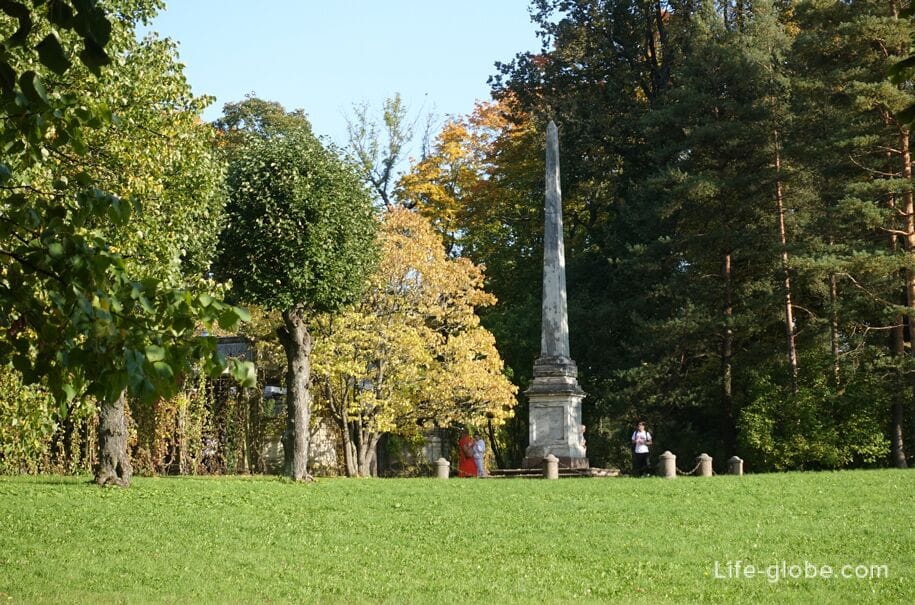
The private garden was made by order of the Emperor Alexander II, in 1865-1886 by the architect A. F. Vidov.
The garden was separated from the rest of the park by an open verandah made in the Italian style - a pergola made of Bremen sandstone at the Peterhof lapidary Factory. This verandah can still be seen today.
The compositional center of the Private Garden is the "Vase" fountain with an octagonal pool with a high vase in the center.
Around the fountain, flower beds are laid out, winding paths run, there are places to relax, sculptures are installed: "Ganymede", a Venetian work of the early 18th century, a copy of one of the" Dancers "by A. Canova and" Nymph " by P. P. Zabello, made in the 19th century. Learn more about the Cahul Obelisk and its Own garden...
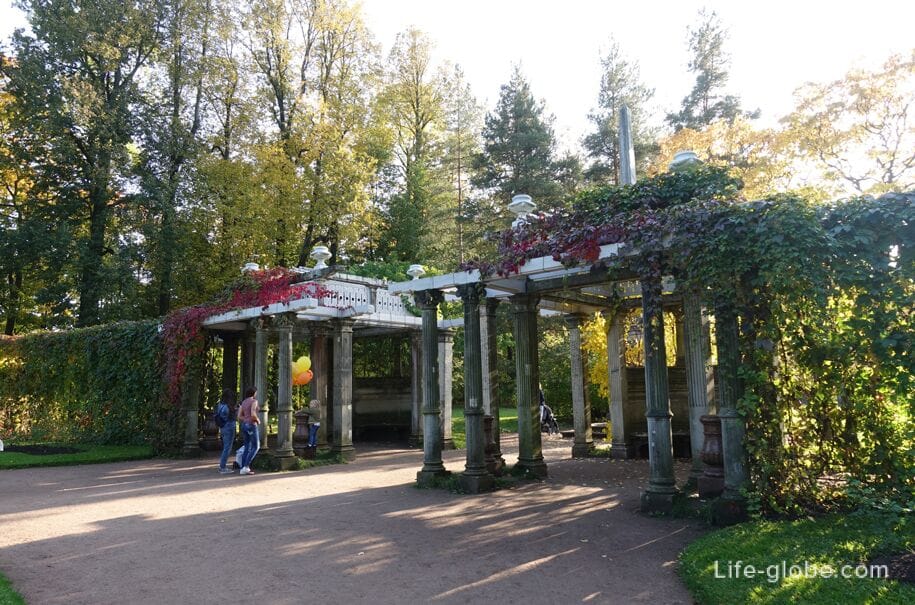
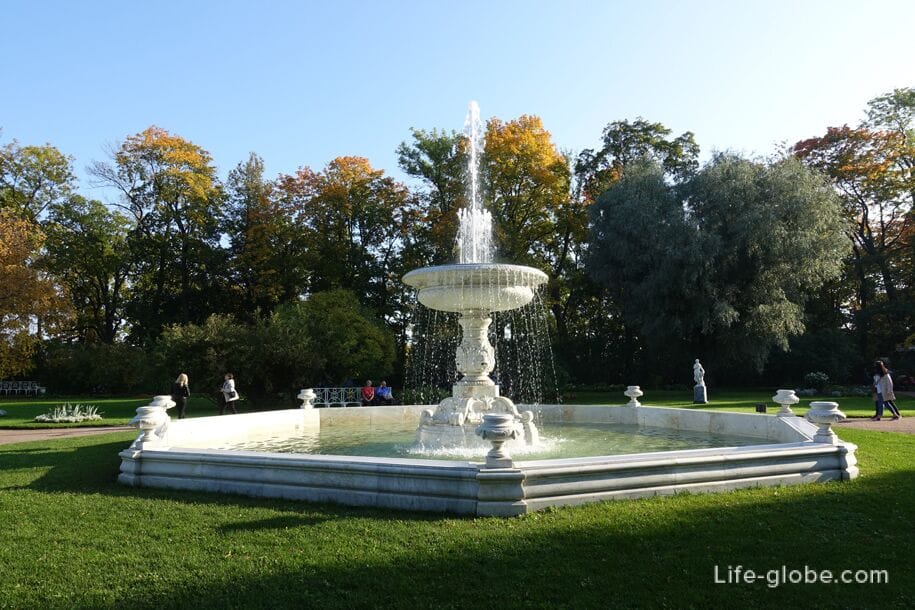
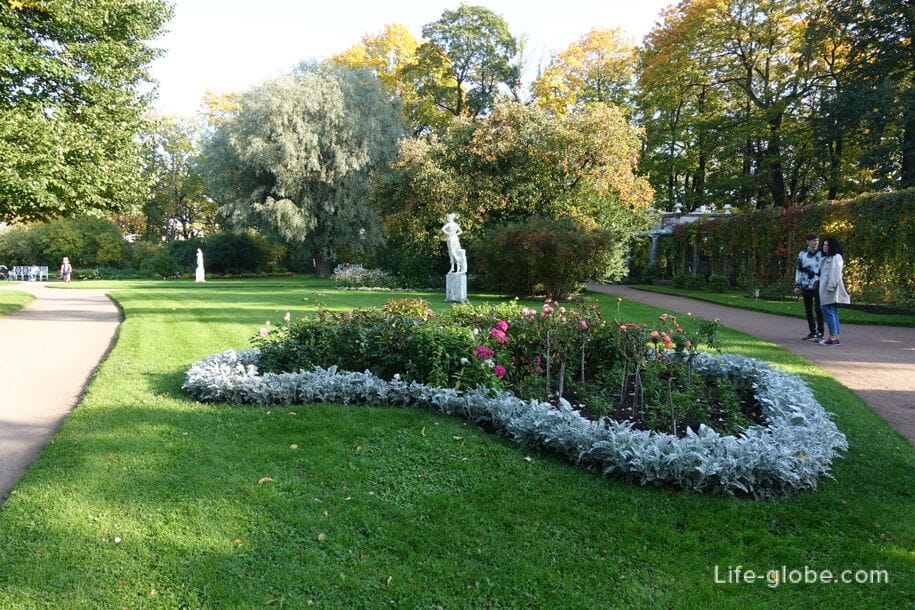
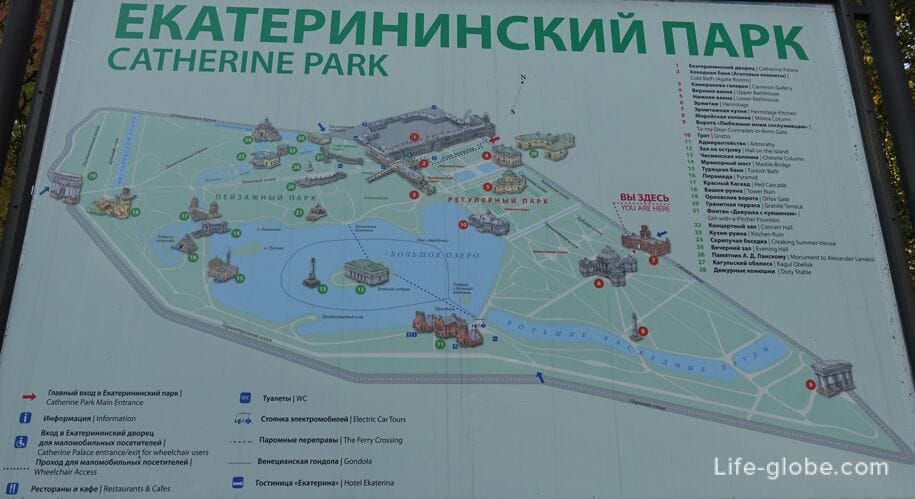
Catherine Park and Catherine Palace are a single palace and park ensemble and are located in the city of Pushkin (formerly Tsarskoye Selo) of St. Petersburg, at the address: St. Petersburg, Pushkin district, Pushkin city, Sadovaya Street, 7.
Coordinates of Catherine Park: 59°42'45.0" N 30°23'53.0" E (59.712500, 30.398056).
Catherine Park with pavilions, together with the Catherine Palace, belong to the State Museum-Reserve "Tsarskoe Selo".
In the summer season (somewhere from the second half of April to mid-October), the entrance to the Catherine Park is paid.
Visits to the Catherine Palace and the pavilions of the park are not included in the price of the entrance to the park-they are paid separately.
The price of tickets to the halls of the palace includes the cost of a ticket to Catherine Park, but without visiting the pavilions-museums of the park.
Tickets to the park, some of the pavilions of the park and the halls of the palace can be purchased at the box office, or in advance-online on the official website.
The opening hours of the park, park pavilions and the palace, as well as temporary exhibitions, visiting conditions and ticket prices, are recommended to check on the website of the State Museum-Reserve "Tsarskoe Selo": tzar.
You can visit Tsarskoye Selo with one of the excursions
In Pushkin, near the Catherine Park and the palace, you can stay
The 5-star Pevcheskaya Tower Hotel features restaurants, a bar, a rooftop observation deck, free Wi-Fi and parking.
Breakfast is included in the room rate. Link to the hotel
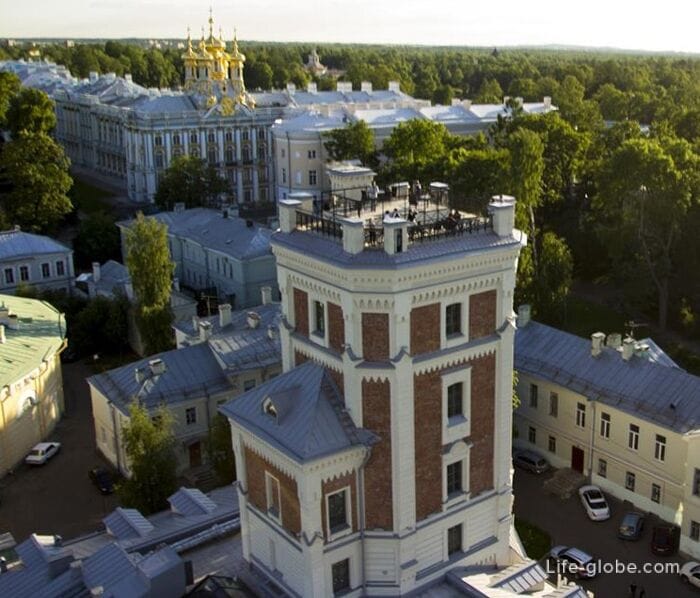
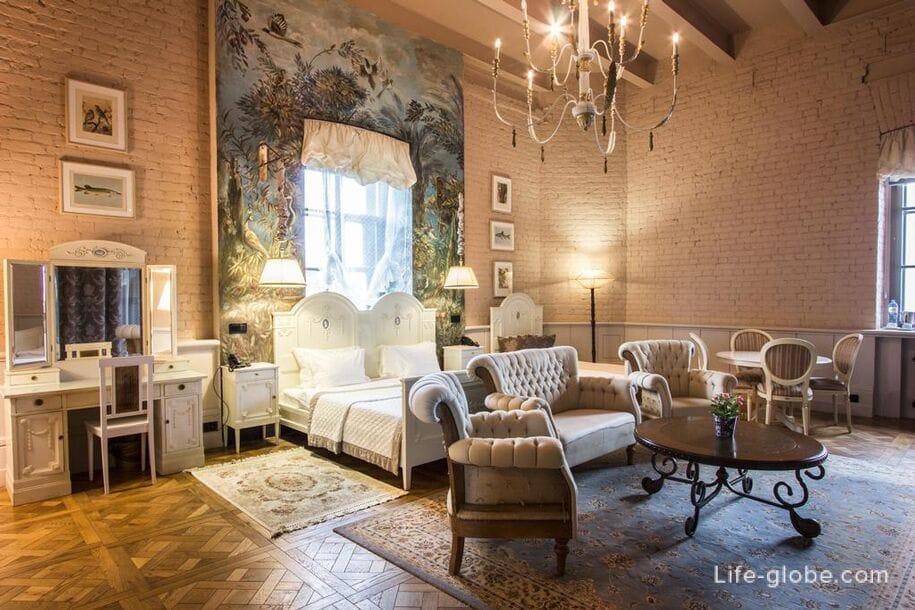
The 5-star luxury spa hotel "Tsar Palace Luxury Hotel & SPA"is located in a historic building.
The hotelfeatures a spa area with a swimming pool, a hammam, a salt sauna, a snow fountain, steam baths and a gym; free Wi-Fi, a 24-hour front desk, 2 restaurants, a lobby bar, private parking and meeting and conference rooms.
The rooms are equipped with climate control, a minibar, a safe and a private bathroom.
A buffet breakfast is included in the room rate. Link to the hotel

3-star hotel Ekaterina, located on the territory of the Catherine Palace and Park Ensemble.
At the hotel: 24-hour front desk, cafe, free Wi-Fi and parking.
Each room here will provide you with air conditioning, a TV, a work desk and free toiletries.
Breakfast is included in the room rate. Link to the hotel
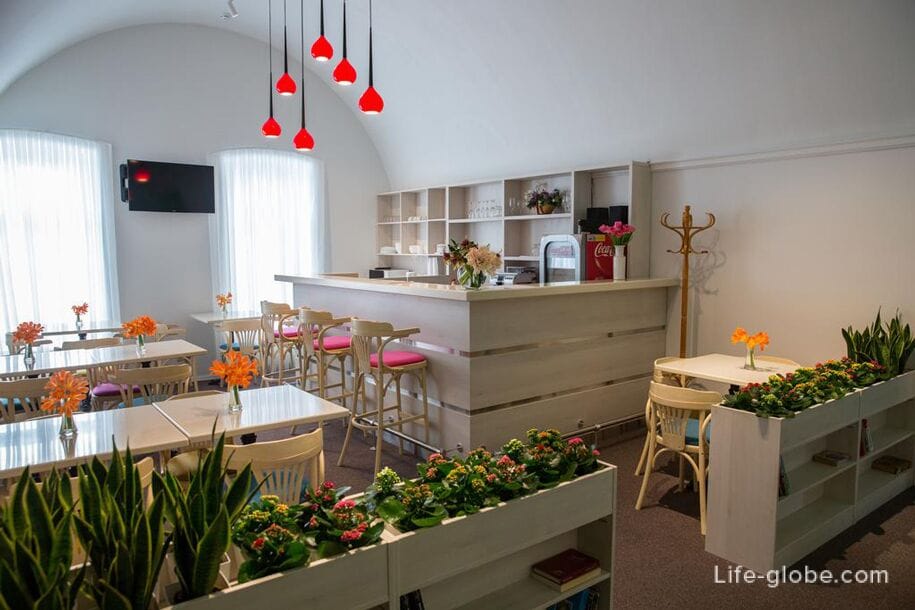
All accommodation facilities in St. Petersburg, including in the city center and in Pushkin, can be viewed and booked here